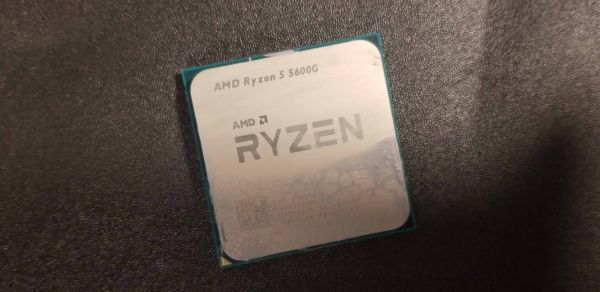Why you can trust Tom's Hardware
AMD Ryzen 5 5600G Integrated GPU Gaming Performance — The TLDR
Head to the bottom of the page to see how the Ryzen 5 5600G stacks up against discrete GPUs.
Below you can see the geometric mean of our integrated graphics gaming tests across five titles at 1280x720 and 1080p, with each resolution split into its own chart to give us a decent overall view of the current landscape. These are cumulative metrics, so individual wins vary on a per-title basis. You'll find the game-by-game test results further below.
We included a test setup with a single channel of memory as a reminder to check the memory configuration on pre-builts, as that is how many OEMs ship their systems. That's particularly painful for APUs. You can read more about that in our Ryzen 7 5700G review.
Here are the test configurations for the entries in the charts below:
- Ryzen 5 5600G: 2x 8GB DDR4-3200 (dual channel) memory @ 16-16-16-36, ASUS ROG Strix B550-E, PBO disabled, Default power limits
- Ryzen 7 5600G PBO + DDR4-4000: 2x 8GB DDR4-3200 (dual channel) memory @ DDR4-4000 19-19-19-48, ASUS ROG Strix B550-E, PBO enabled, FCLK at 2000 MHz (1:1 coupled mode), RX Vega at 2300 MHz
- Ryzen 7 5700G B550: 2x 8GB DDR4-3200 (dual channel) memory @ 16-16-16-36, ASUS ROG Strix B550-E, PBO disabled, Default power limits
- Ryzen 7 5700G HP Single Channel: 1x 16GB DDR4-3200 (single channel) memory @ 22-22-22-52, HP Pavilion TP01-2066, No configurable options
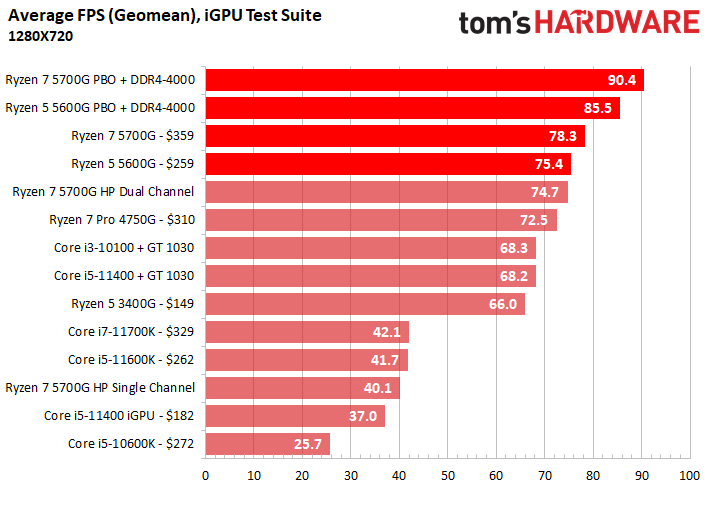
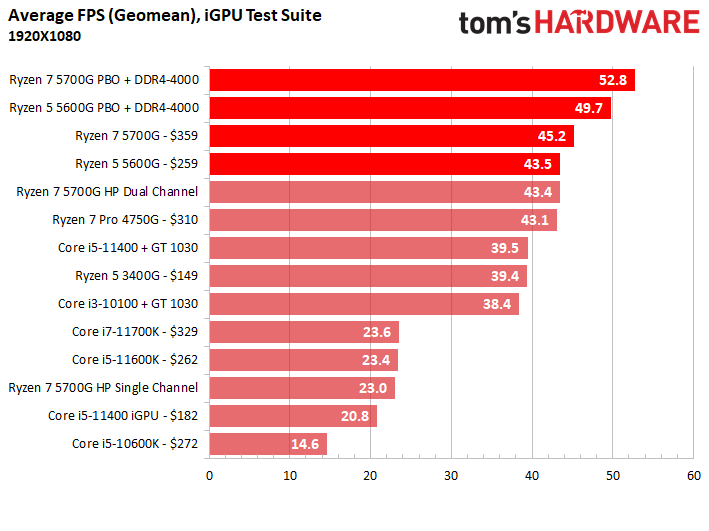
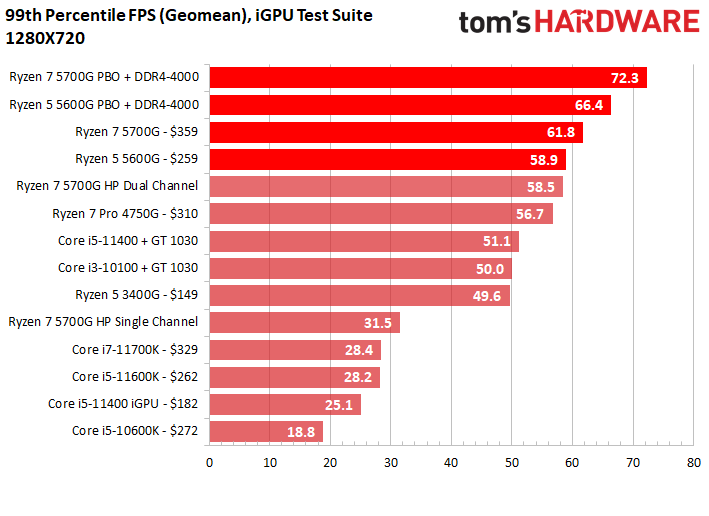
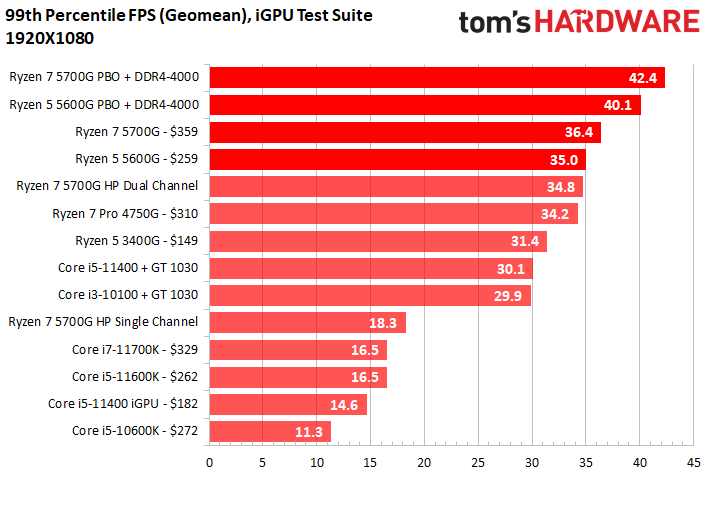
| Row 0 - Cell 0 | 1280x720 | 1920x1080 |
| Ryzen 7 5700G | 100% | 100% |
| Ryzen 5 5600G | 96.3% | 96% |
| Ryzen 7 4750G | 92.9% | 94.1% |
| Ryzen 5 3400G | 83.5% | 84.1% |
| Intel UHD Graphics 750 32 EU (11600K, 11700K) | 58.3% | ~48.9% |
| Intel UHD Graphics 730 24 EU (i5-11400) | 51.7% | 42.9% |
| Intel UHD Graphics 630 24 EU (10600K) | 36.0% | 34.4% |
The table above gives us a performance comparison of the most relevant chips, with the Ryzen 7 5700G used as the baseline. Again, the Zen 3 architecture pays dividends as the six-core 5600G beats the Ryzen 7 4750G with the Zen 2 architecture by ~3%. That doesn't sound too impressive until we mention the 4750G has two more CPU cores, an extra graphics core, and 200 MHz higher graphics clocks with what appears to be a similar 7nm Vega engine.
Zooming out to the previous-gen comparable chips that you can actually buy at retail, the 5600G beats the quad-core 3400G by 13% at 1280x720 and 12% at 1080p.
The biggest testament to the 5600G's strength comes from simply comparing it to the eight-core Ryzen 7 5700G. While the $359 Ryzen 7 5700G has two extra CPU cores, one extra CU, and higher GPU clocks, the $258 Ryzen 5 5600G lands within 4% at both resolutions — but for 30% less cash. Clearly, as expected, the shared memory bandwidth is more of a factor than raw compute.
The Intel chips give us about what we expect, roughly the same (or slightly less) performance than the crippled Ryzen 7 5700G with a single memory stick. Intel's UHD Graphics 750 engine with the Xe architecture is a decent improvement over the company's UHD Graphics 630 engine, but Intel ported the Xe architecture back to the 14nm process, resulting in fewer graphics cores. As such, the highest-end desktop chips currently have 32 EUs, whereas the 10nm Tiger Lake chips stretch up to 96 EU.
The 11700K and 11600K with UHD Graphics 750 struggle at both 1280x720 and 1080p, netting roughly half the performance of a properly configured Ryzen 7 5700G system. The Core i5-11400 fares even worse; its UHD Graphics 730 engine only comes with 24 EUs. Intel has made strides compared to the UHD Graphics 630 engine in the 10600K, which also comes with 24 EUs, but the best Intel chips still trail AMD's three-year-old Ryzen 5 3400G 'Picasso' chips by significant margins.
Get Tom's Hardware's best news and in-depth reviews, straight to your inbox.
We also include tests systems equipped with the $182 Core i5-11400 and $122 Core i3-10100 paired with a GT 1030 as a point of reference. Given today's scalper pricing, the GT 1030 can be had for around $180 at retail, and if you can find the CPUs at MSRP, the ~$360 Core i5-11400 system would compete with the Ryzen 7 5700G, while the ~$300 Core i3-10100 system would kind of compete with the Ryzen 5 5600G.
The Ryzen 5 5600G is the better buy here — you simply can't match that level of performance with a GPU bought at retail, like the GT 1030. You should also bear in mind that one of our benchmarks, Grand Theft Auto V, netted a large win for the GT 1030 configs that isn't represented in any other title we tested, thus inflating the score you see above. The 5600G value story relative to low-end discrete GPUs could change a bit if you broaden your horizons to second-hand previous-gen GPUs you can buy on eBay, etc., but fickle pricing makes that a tough compare that could vary significantly based on GPU. Unless pricing for used discrete GPUs changes dramatically soon, we think you'll be hard-pressed to beat the 5600G with an Intel-powered combo.
Overall, the results are clear: If you're looking for the best integrated graphics on the desktop, Cezanne is the new leader for desktop PCs. Overall the Ryzen 5 5600G gives you the lion's share of the Ryzen 7 5700G's performance, but at a much more accessible price point.
We found 1280x720 gaming to be solid across numerous titles with the Ryzen 5 5600G chip. While the number of titles you can play becomes extremely restricted at 1080p, you can get away with 1080p gaming with reduced fidelity settings in many titles, too.
Far Cry 5 on AMD Ryzen 5 5600G
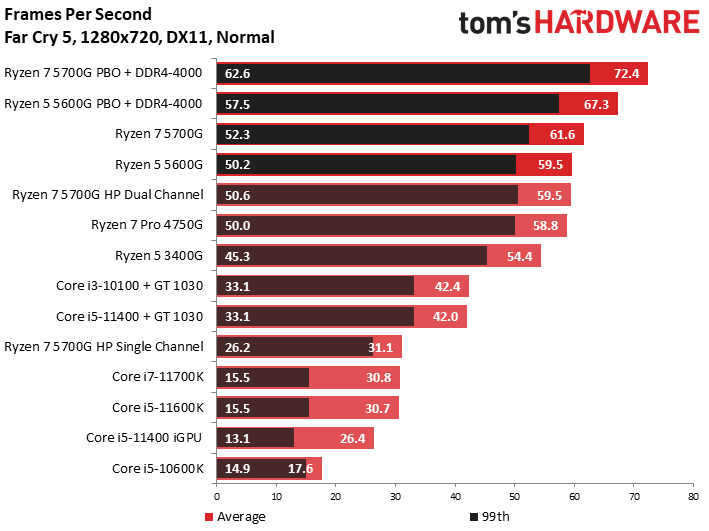

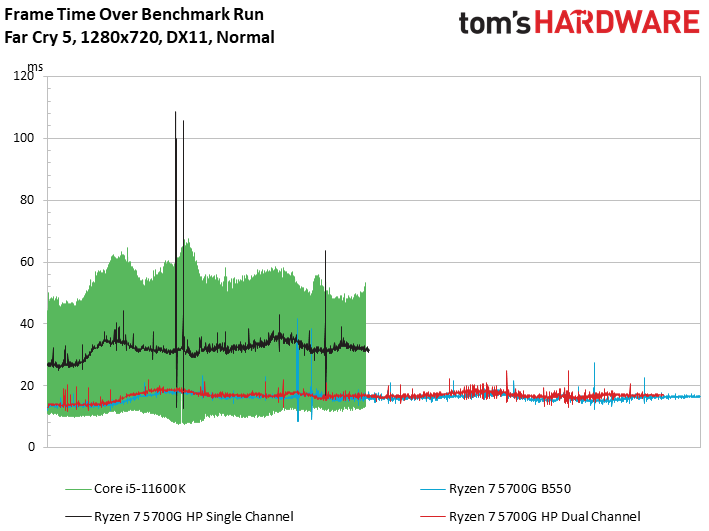
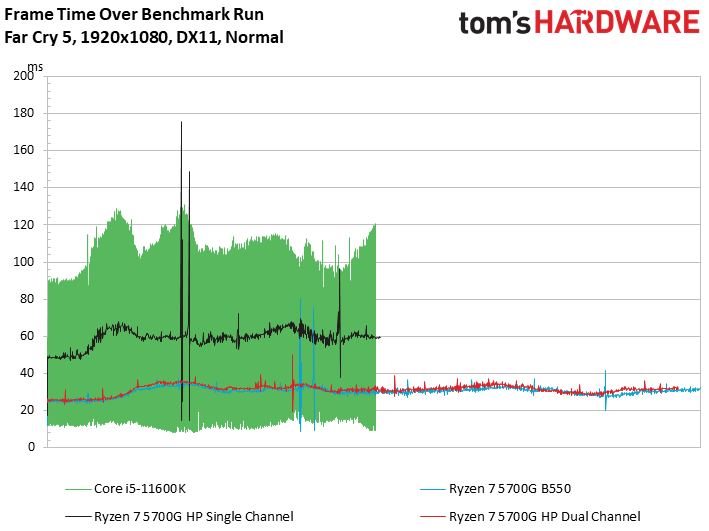
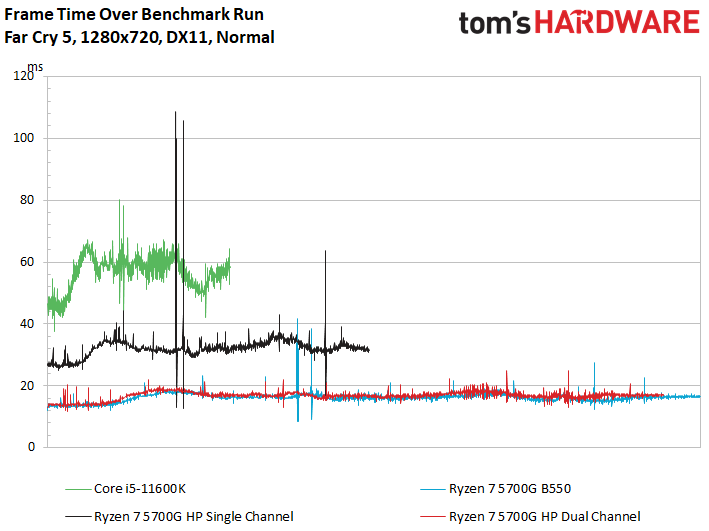
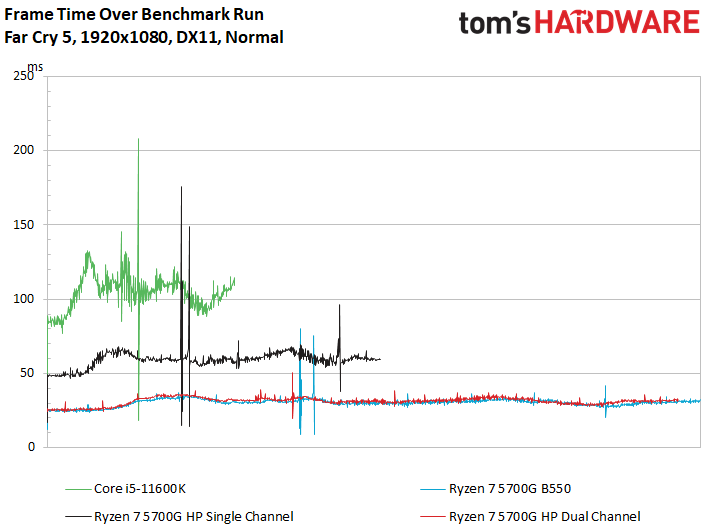
The previous-gen Ryzen 7 4750G is roughly 1% faster than the Ryzen 5 5600G at 1080p, marking one of the few times we'll see the more handsomely-equipped (at least in terms of CPU and GPU cores) previous-gen model take the lead over the 5600G, highlighting that the 5600G takes a big leap forward.
The 5600G provided smooth gameplay at 1280x720, but it did get a bit dicey at 1080p. You could loosen your fidelity settings a bit more to help alleviate the issue or turn to overclocking to boost performance. As you can see, the chip responds readily to extra memory throughput.
In contrast, the Rocket Lake chips suffered throughout our Far Cry 5 tests, and we couldn't correct the issue. Flipping to the last slides in the above album shows the problem — the Cezanne setups deliver smooth and predictable frame rates. In contrast, the Intel Rocket Lake chips are incredibly inconsistent, instead delivering hitching, stuttering, and generally unplayable performance. Those same trends carry over to the Core i5-11400, too.
Far Cry 5 isn't playable on the 10600K with its previous-gen UHD Graphics 630, but it does have a consistent frame rate profile. That means this odd frame rate variance issue is confined to Intel's UHD Graphics 750 engine, at least on our testbed.
Unfortunately, we've encountered similarly rocky performance with a few titles that we've tested with Intel's new Xe architecture on the Rocket Lake chips, but driver updates have ironed out most of the wrinkles. These are probably early teething problems with drivers and game code as Intel works with its new graphics architecture, but some of these problems have existed for the four long months since the Rocket Lake launch.
We didn't encounter any of these issues with Intel's previous-gen UHD Graphics 630 engine or the Ryzen chips, and even the crippled HP single-channel setup beats the Intel chips.
Grand Theft Auto V on AMD Ryzen 5 5600G
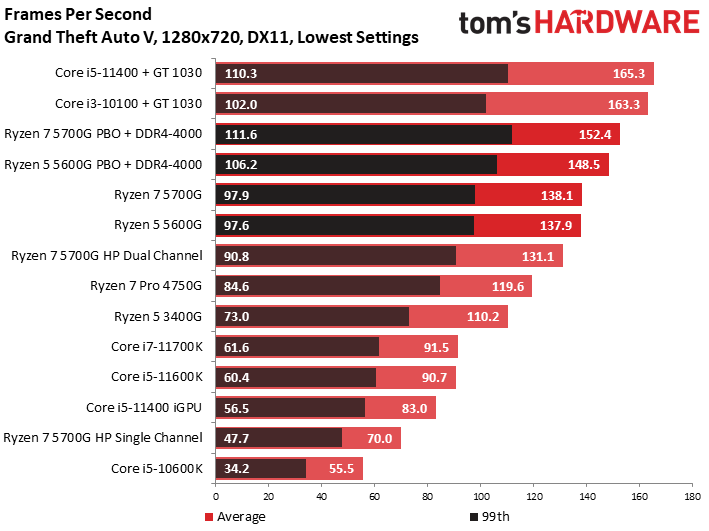

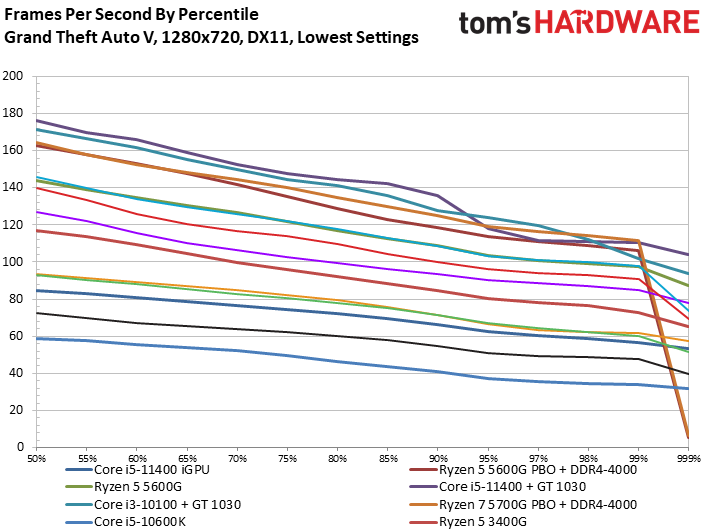

Grand Theft Auto V is immortal, partly because you can play it on lower-powered hardware if you're willing to trade off fidelity for performance.
Dialing back to the lowest quality settings yields a very playable 85.4 fps at 1080p for the Ryzen 5 5600G while stepping up to the 5700G nets ~1% more performance. That means there's plenty of headroom for higher quality settings, and that applies nearly doubly at the 1280x720 resolution; the 5600G's impressive 137.9 fps leaves plenty of room for tweaking.
You'll notice that the Intel + GT 1030 configurations pull ahead in this benchmark. GTAV has historically favored Intel CPU architectures, and we theorize that memory throughput may play a role here, too. In either case, this marks the lone win for the GT 1030 configurations and helps inflate thier relative scores in our cumulative performance measurements above.
Shadow of the Tomb Raider on AMD Ryzen 5 5600G
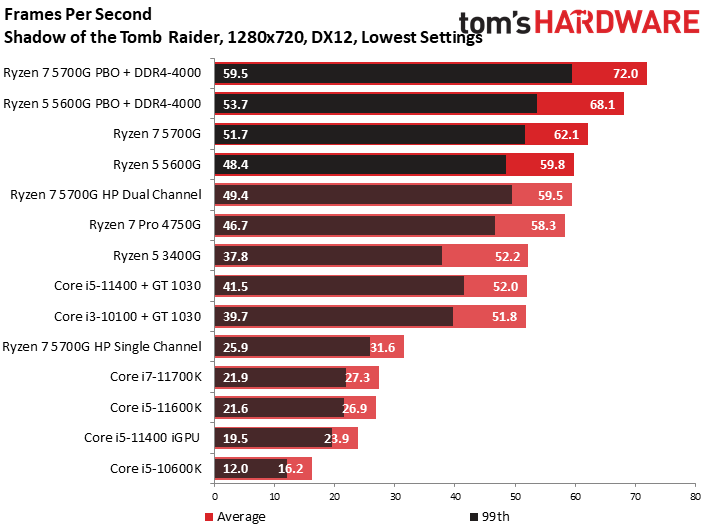
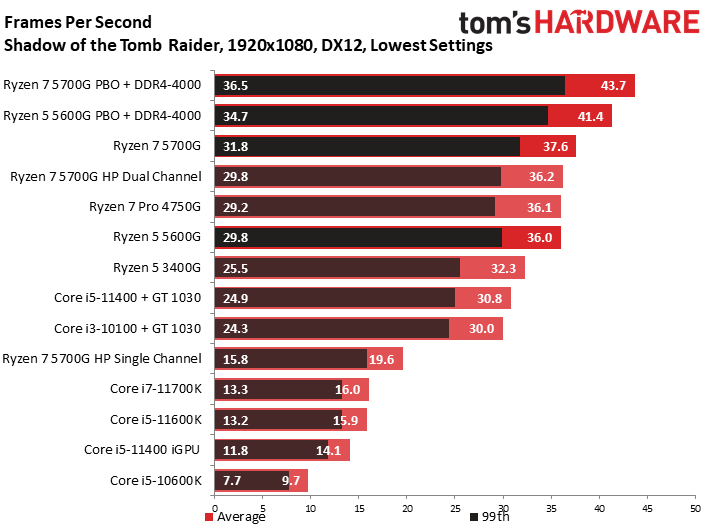
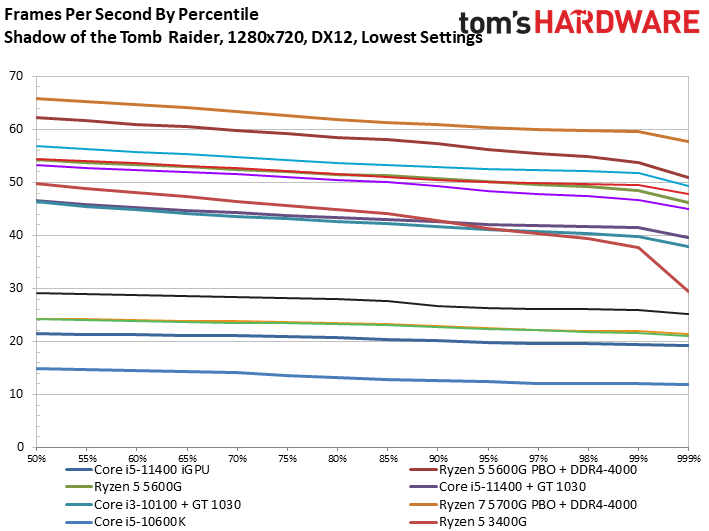
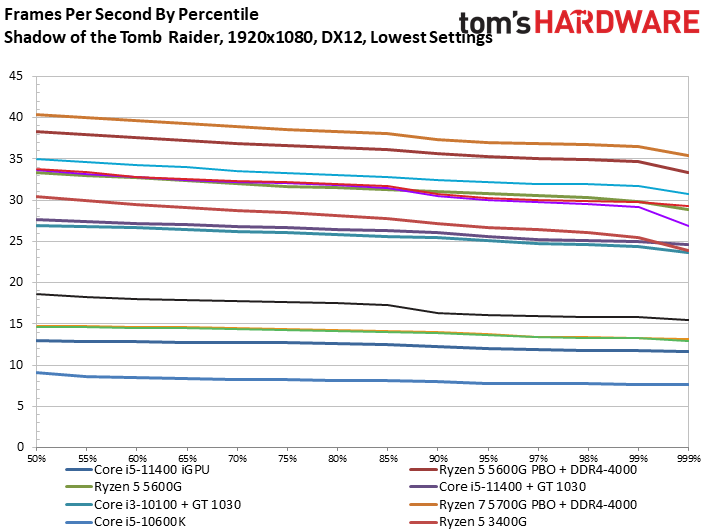
The Intel chips suffered in Shadow of the Tomb Raider, too. The Core i7-11700K and i5-11600K offer nearly identical performance in the 1080p benchmark, showing we've reached a graphics bottleneck that the 11700K's slightly higher CPU clock rate can't improve. The Core i5-11400, with its pared-back engine with 24 EUs, suffers even more.
The Ryzen 7 5700G is ~4% faster than the 5600G at 1280x720 and 1080p, a pretty slim performance delta given the 5700G's $100 higher price tag.
The Ryzen 5 5600G is ~12% faster at both resolutions than the Ryzen 5 3400G. Against the 4750G, the 5600G's lead shrinks to 2% at 1280x720, and it provides identical performance at 1080p, but that's largely inconsequential. The 4750G is OEM-only, so if you don't plan on buying a pre-built system, you'll have to pay scalper pricing. As shown in our Ryzen 7 4750G review, that kills the 4750G's value proposition.
Strange Brigade on AMD Ryzen 5 5600G
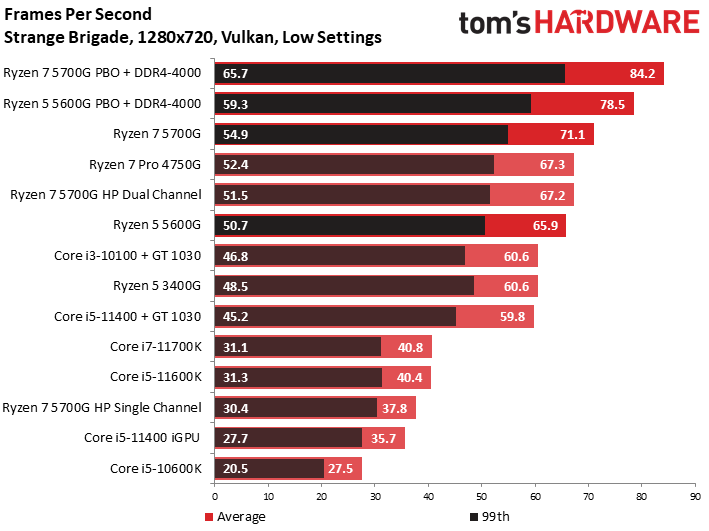
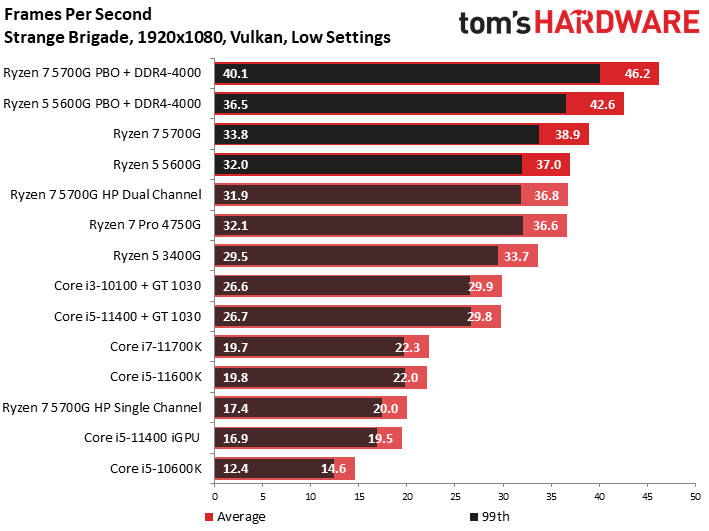
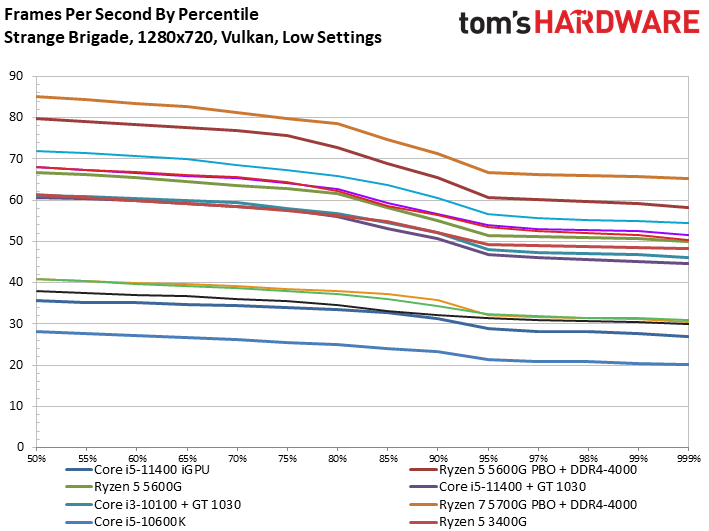
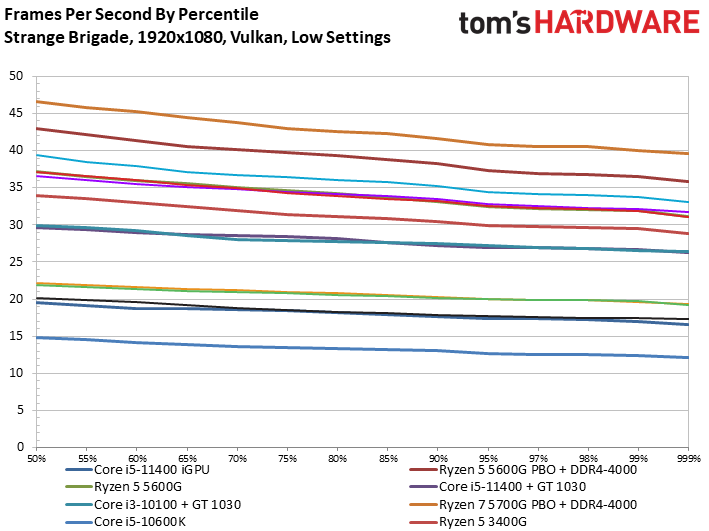
Our last foray into testing the Xe architecture in Strange Brigade happened at the Rocket Lake launch, and try as we might, we couldn't get the cursor to appear on the screen. However, newer drivers (or perhaps a game update?) have fixed that issue.
Strange Brigade now works just fine on our test system, but the 5600G is ~60 to 65% faster than the UHD Graphics 750 engine in this benchmark, putting the finishing touch on Cezanne's commanding performance in our integrated graphics test suite.
Ryzen 5000G Integrated Graphics Performance Compared to Discrete GPUs
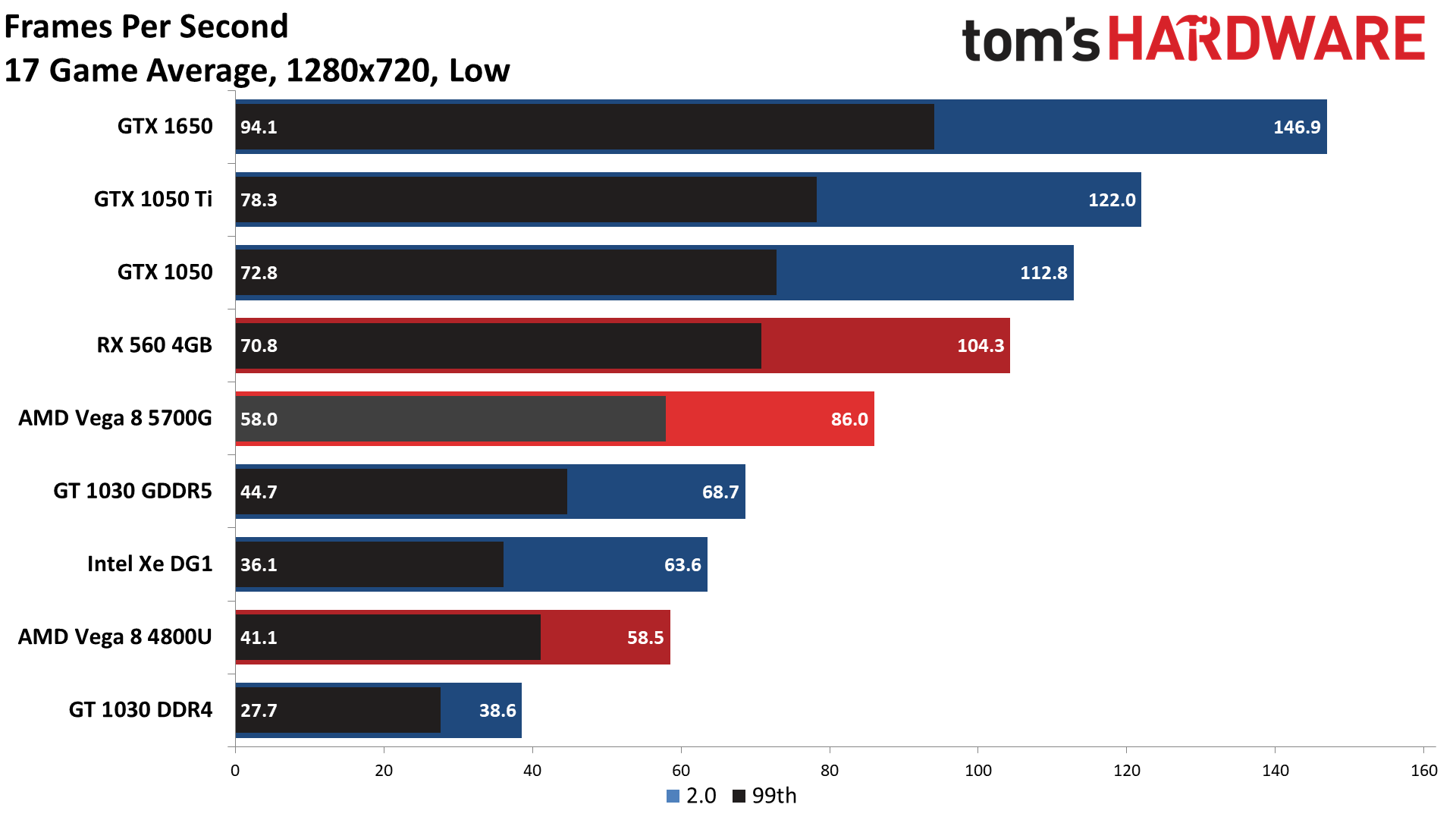
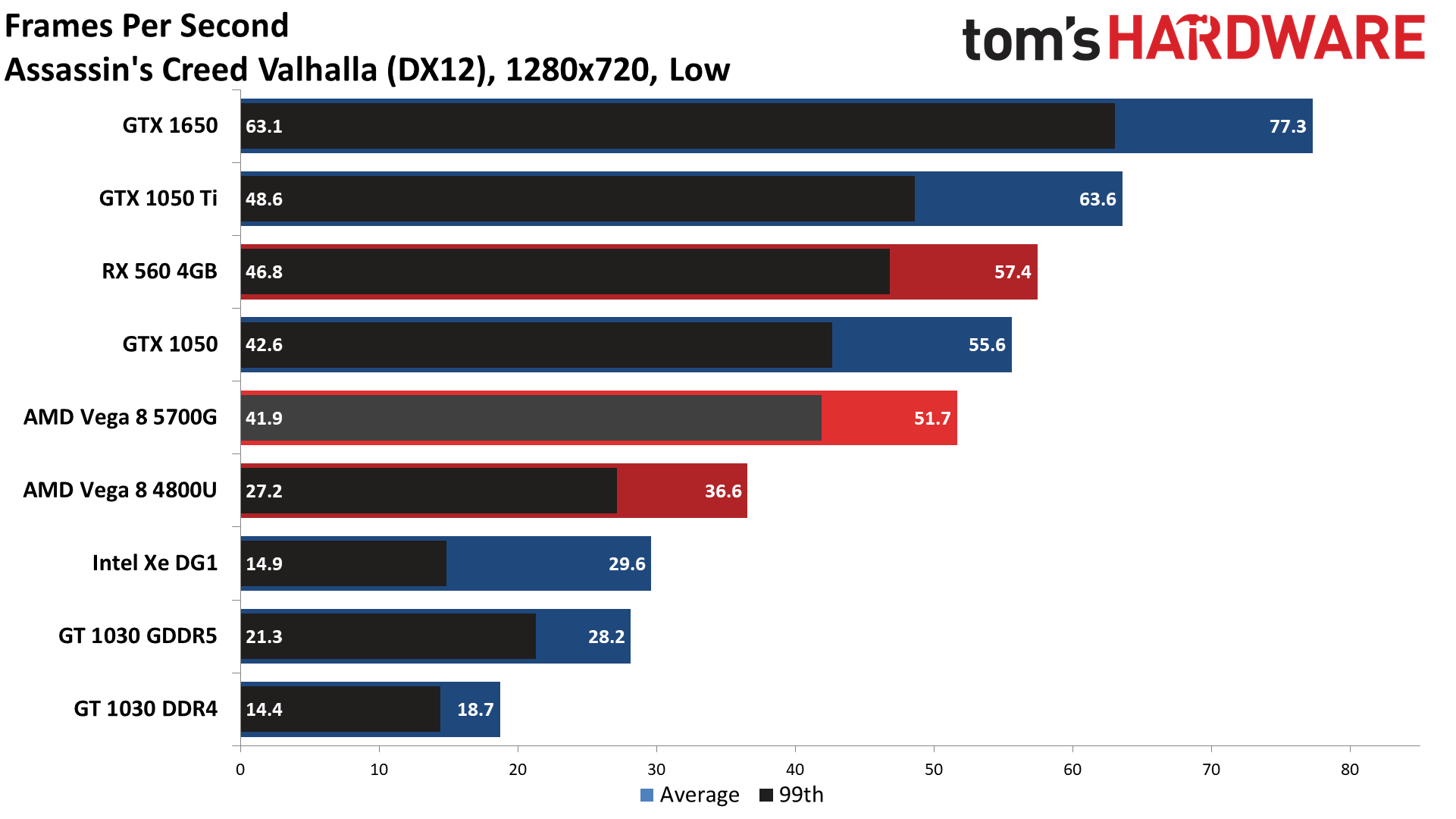
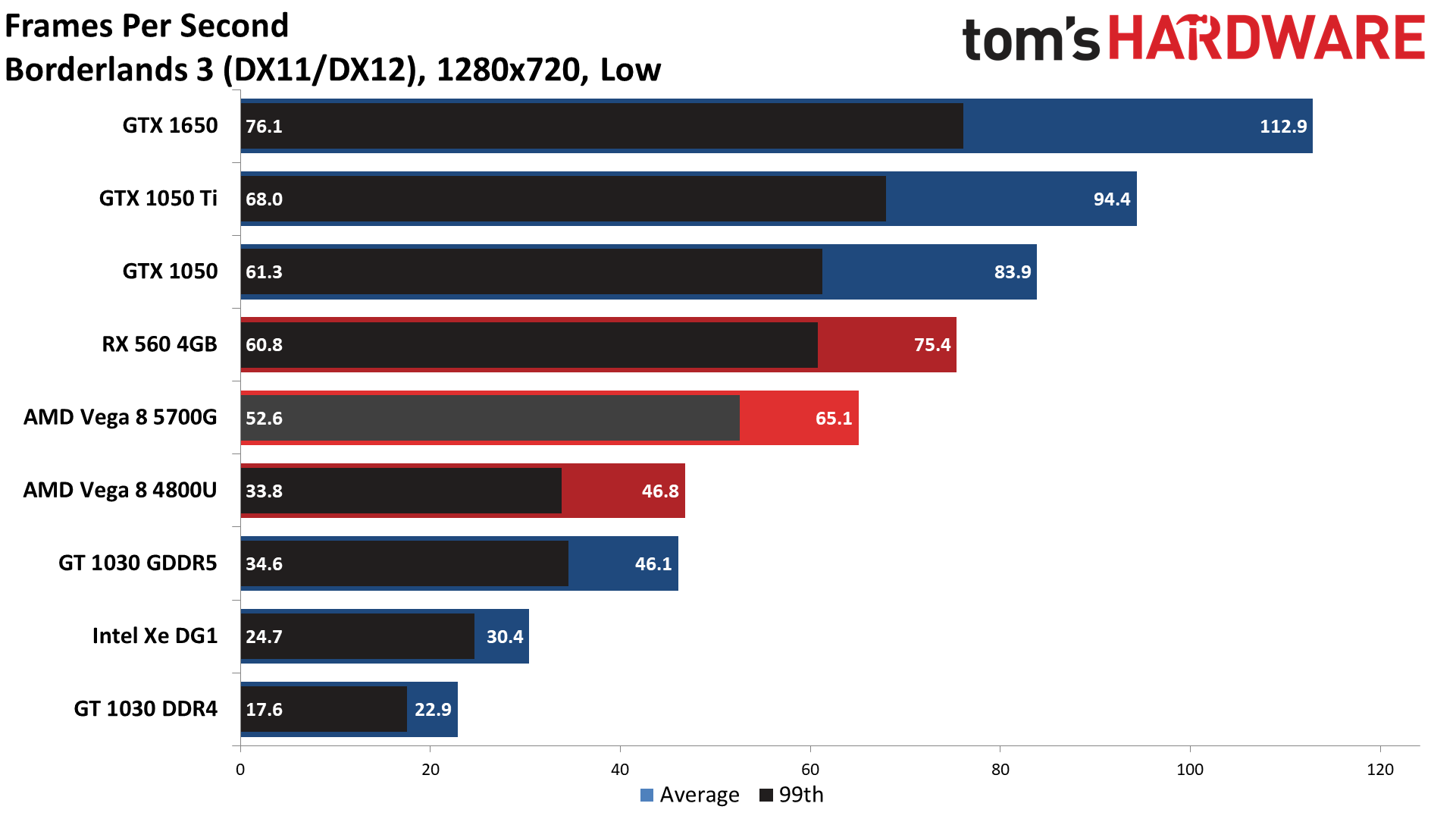
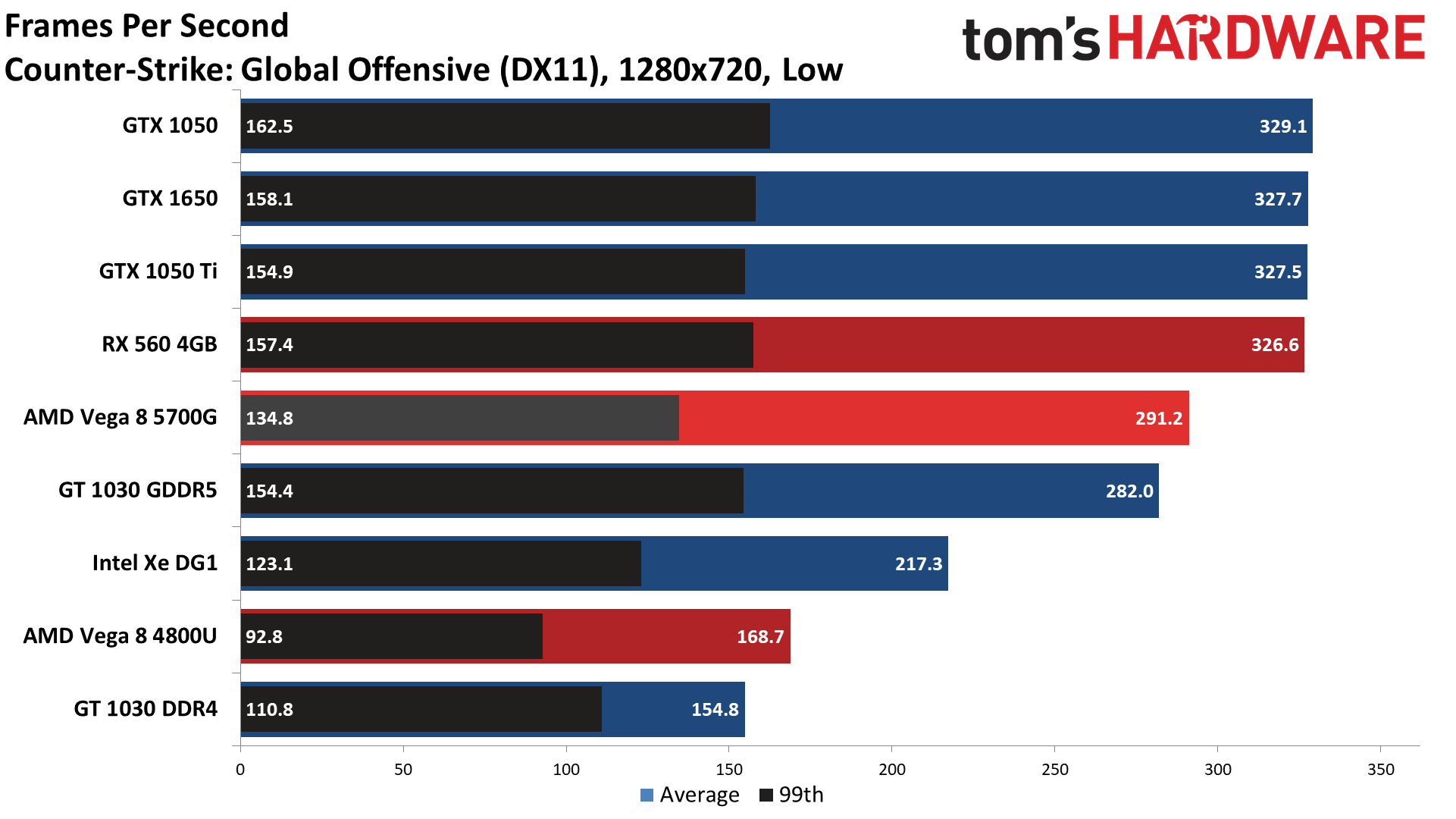
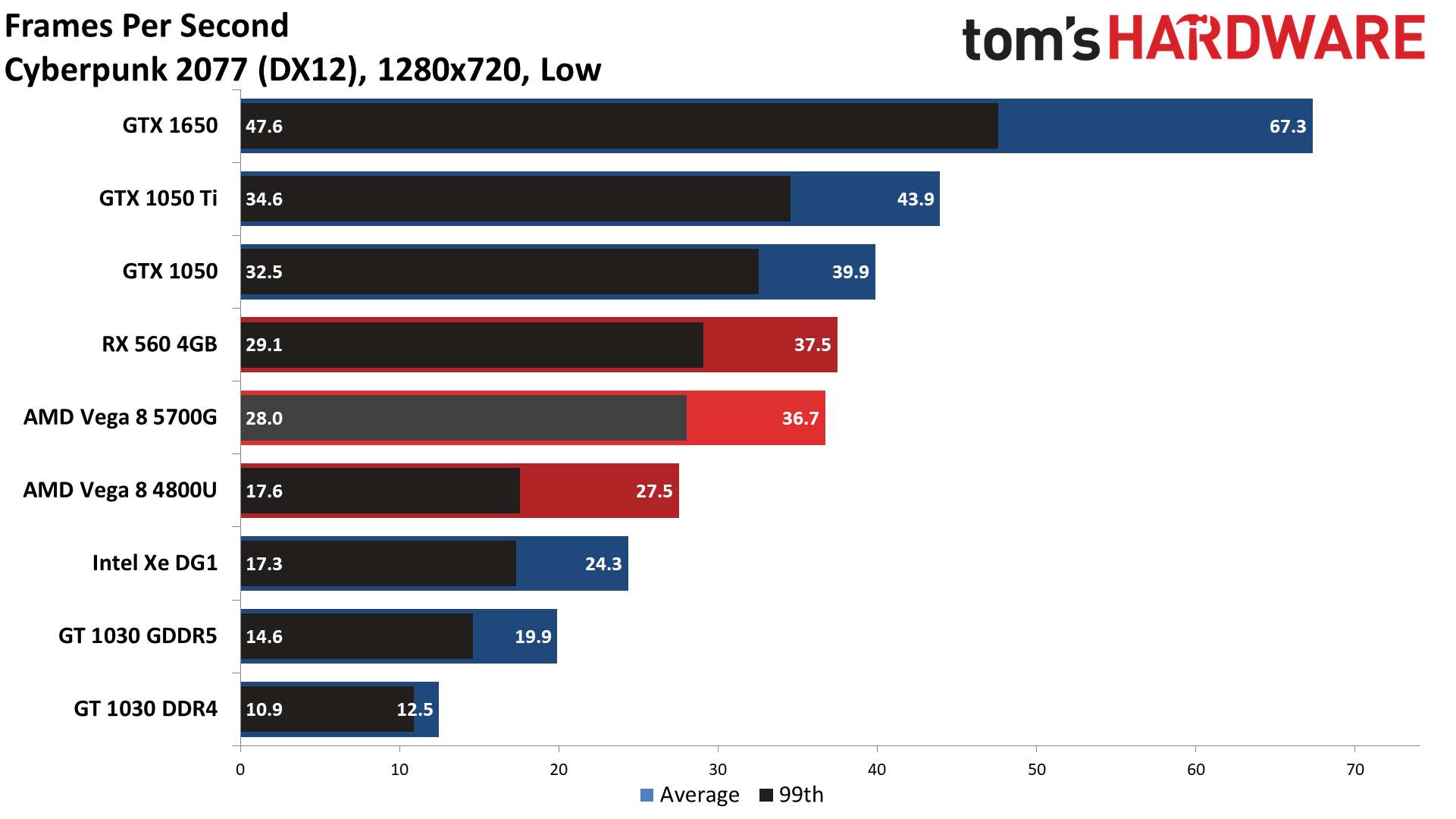
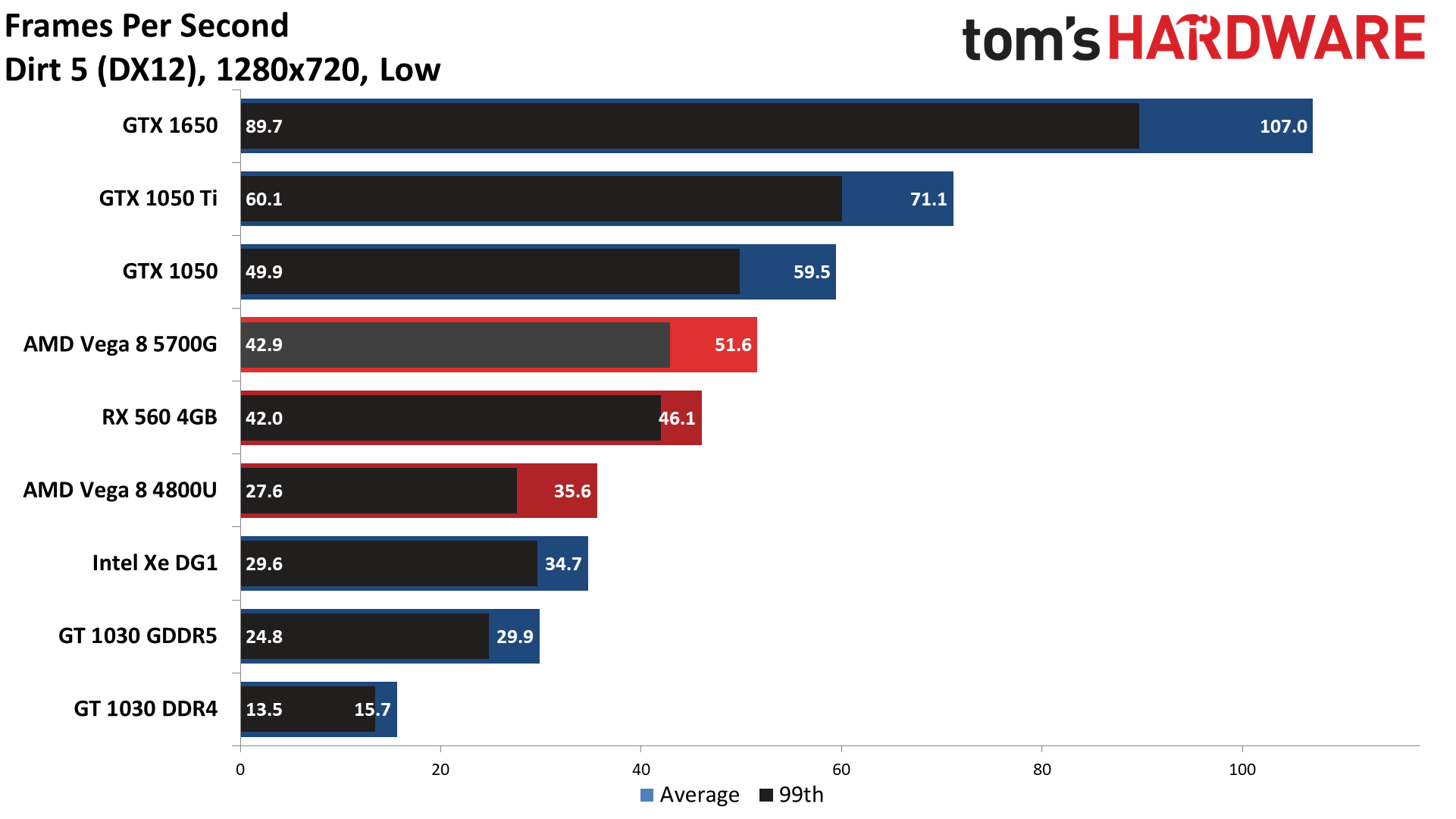
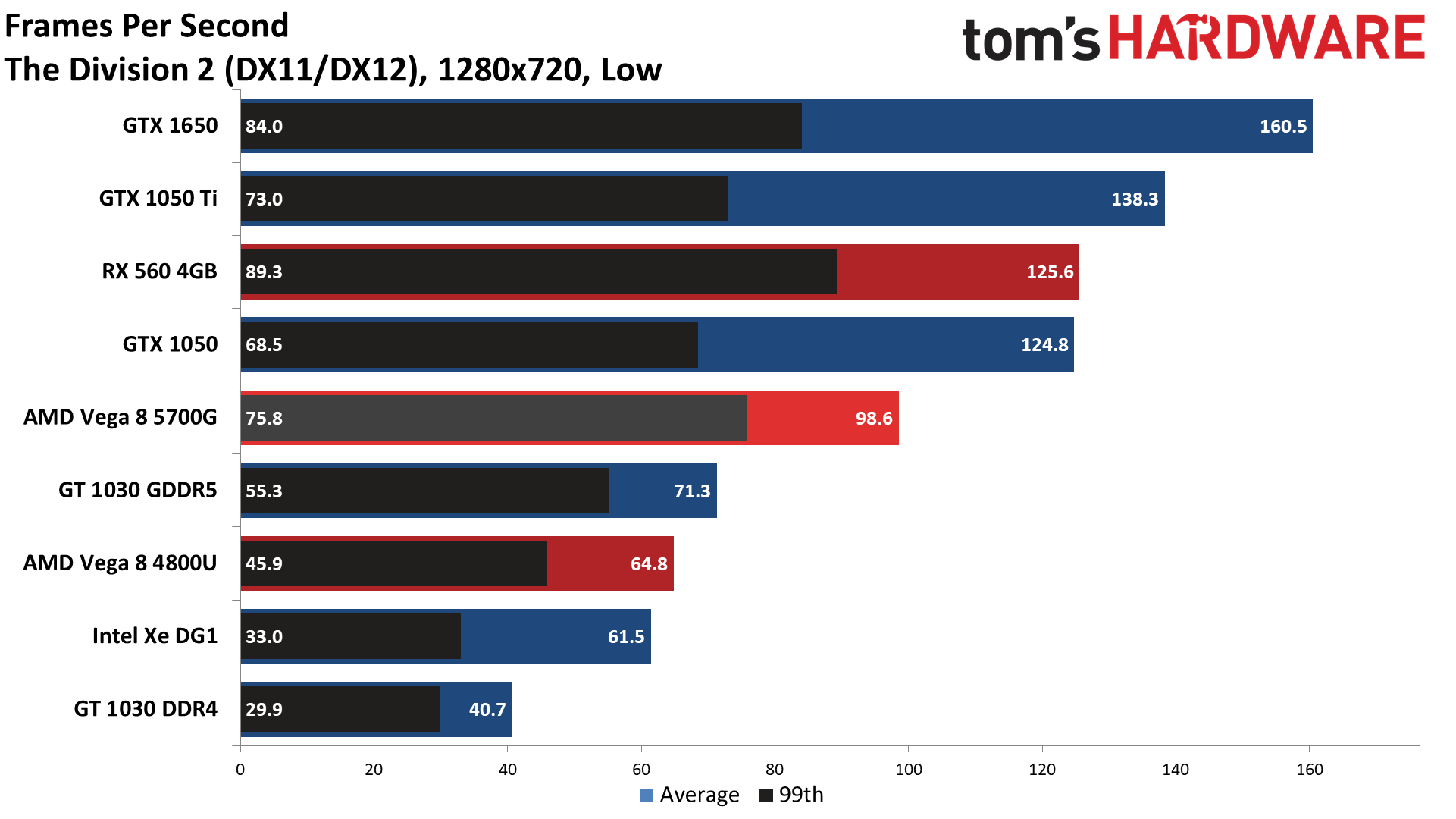
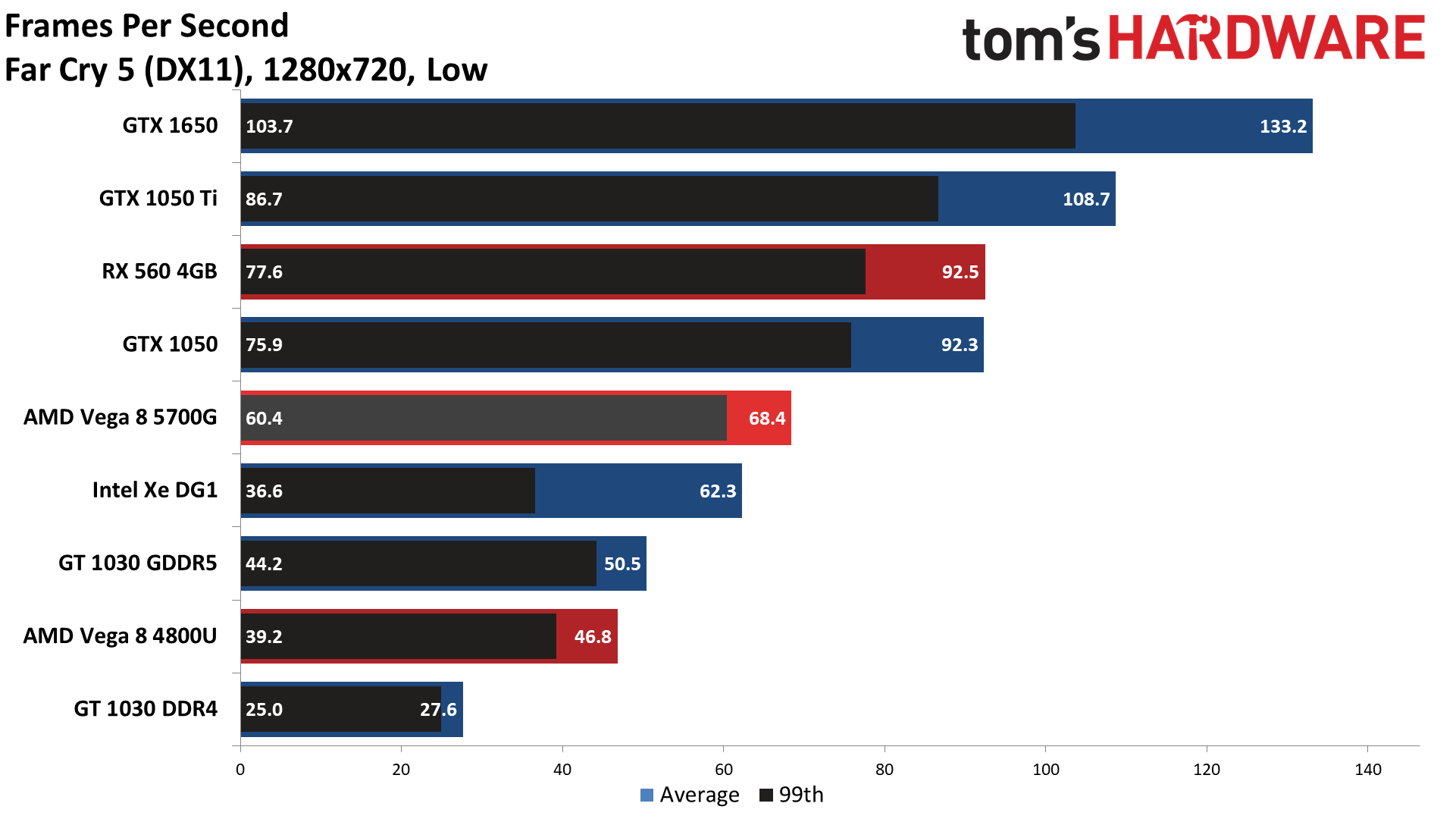
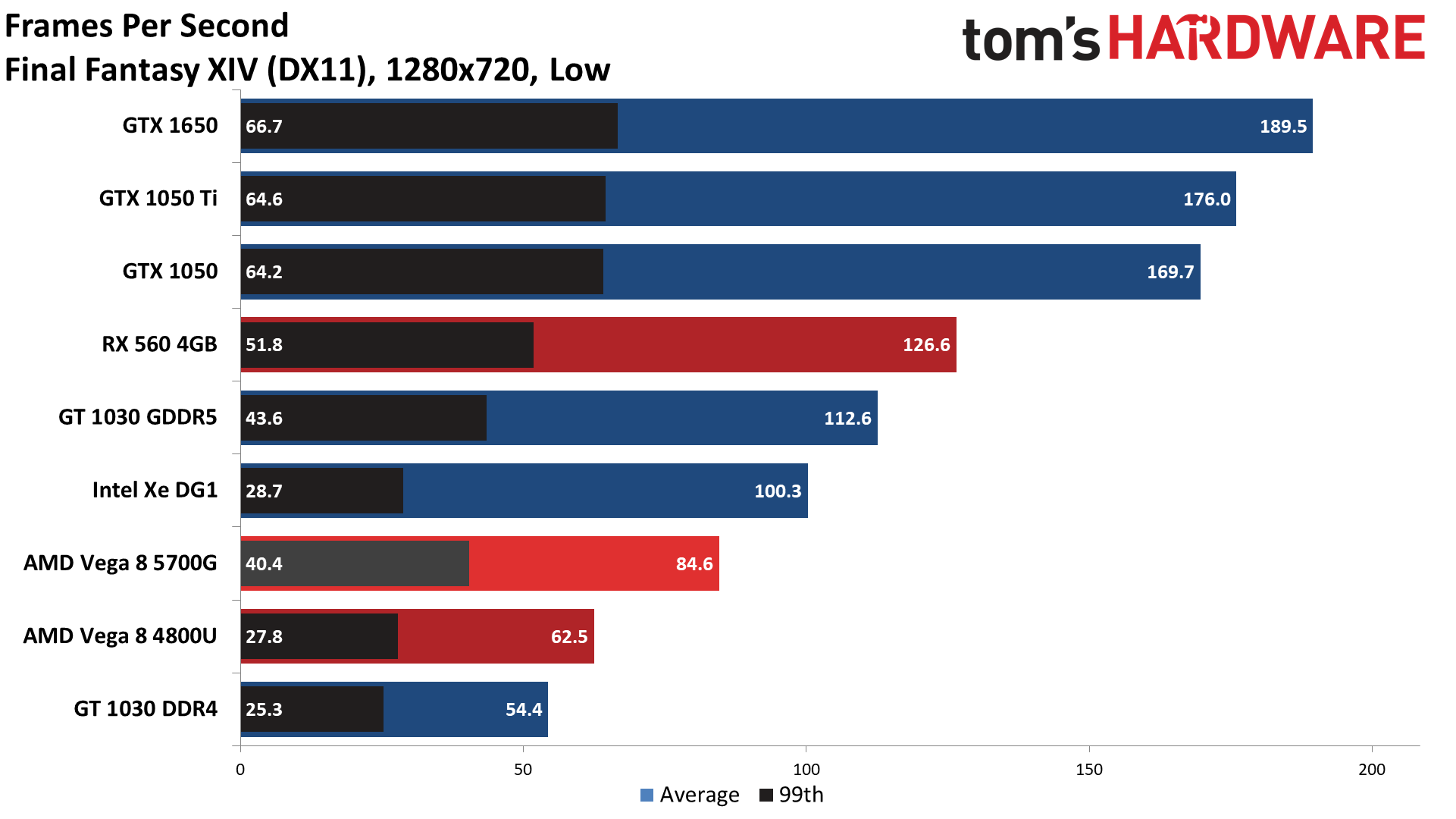

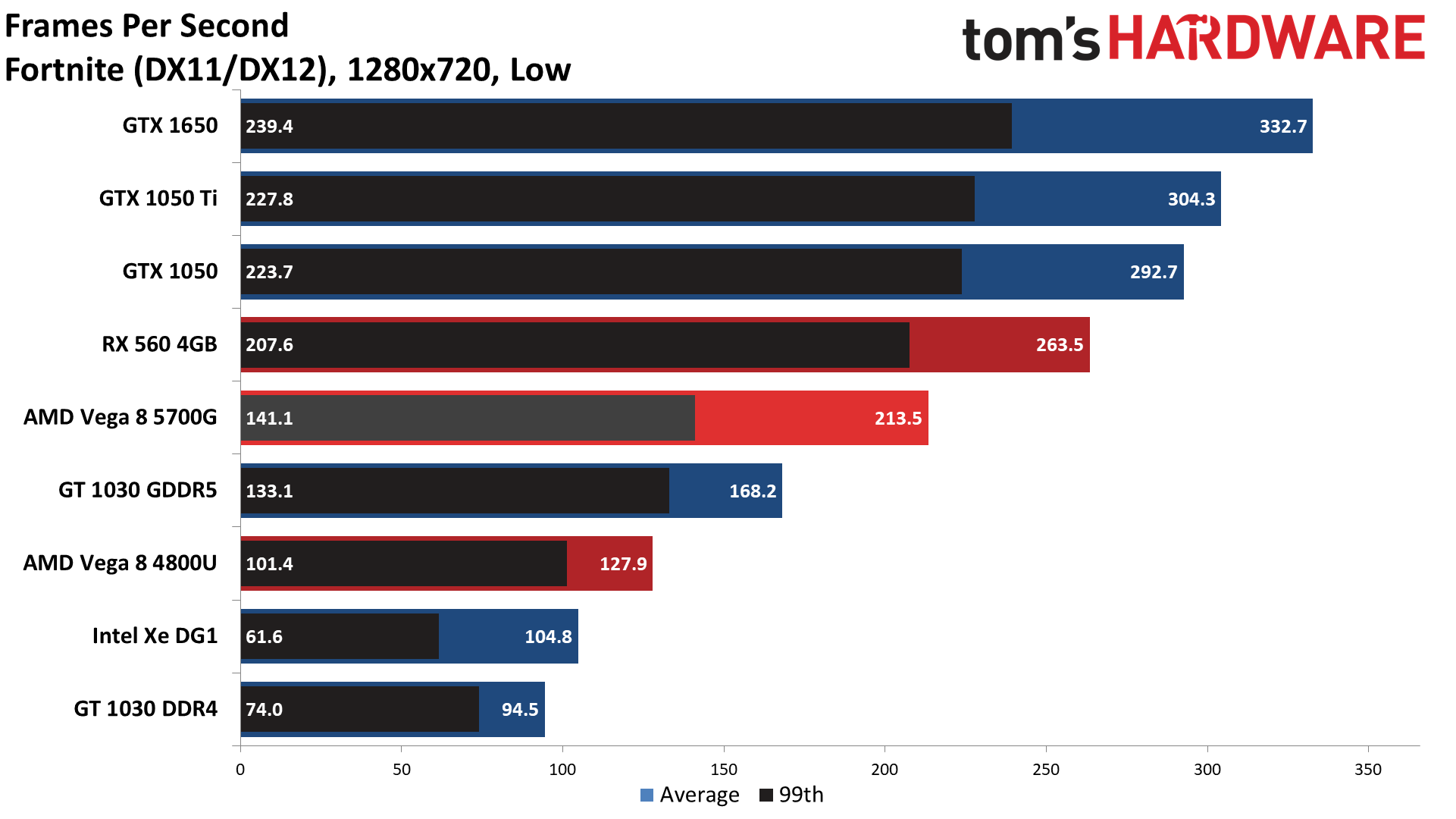
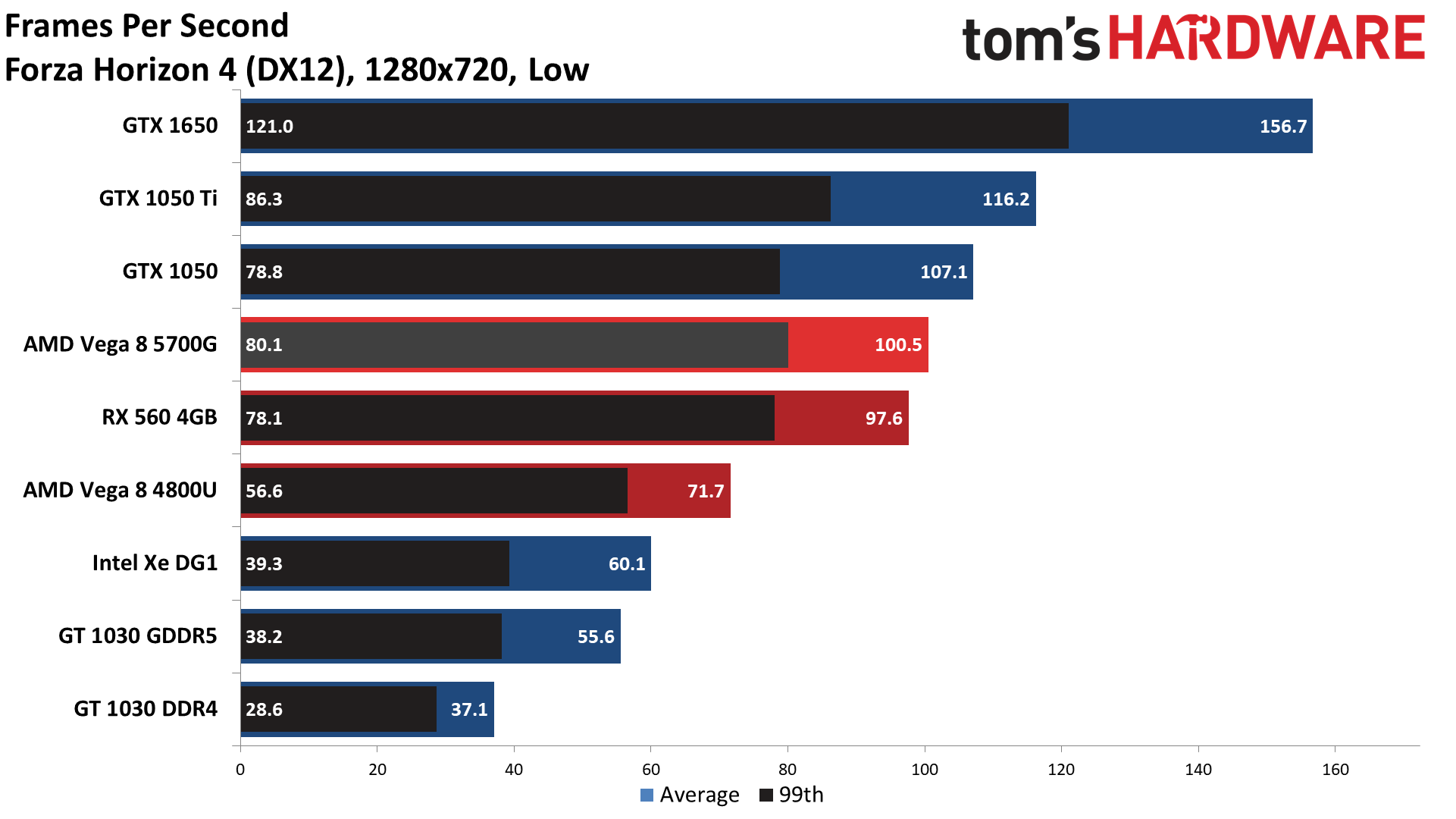
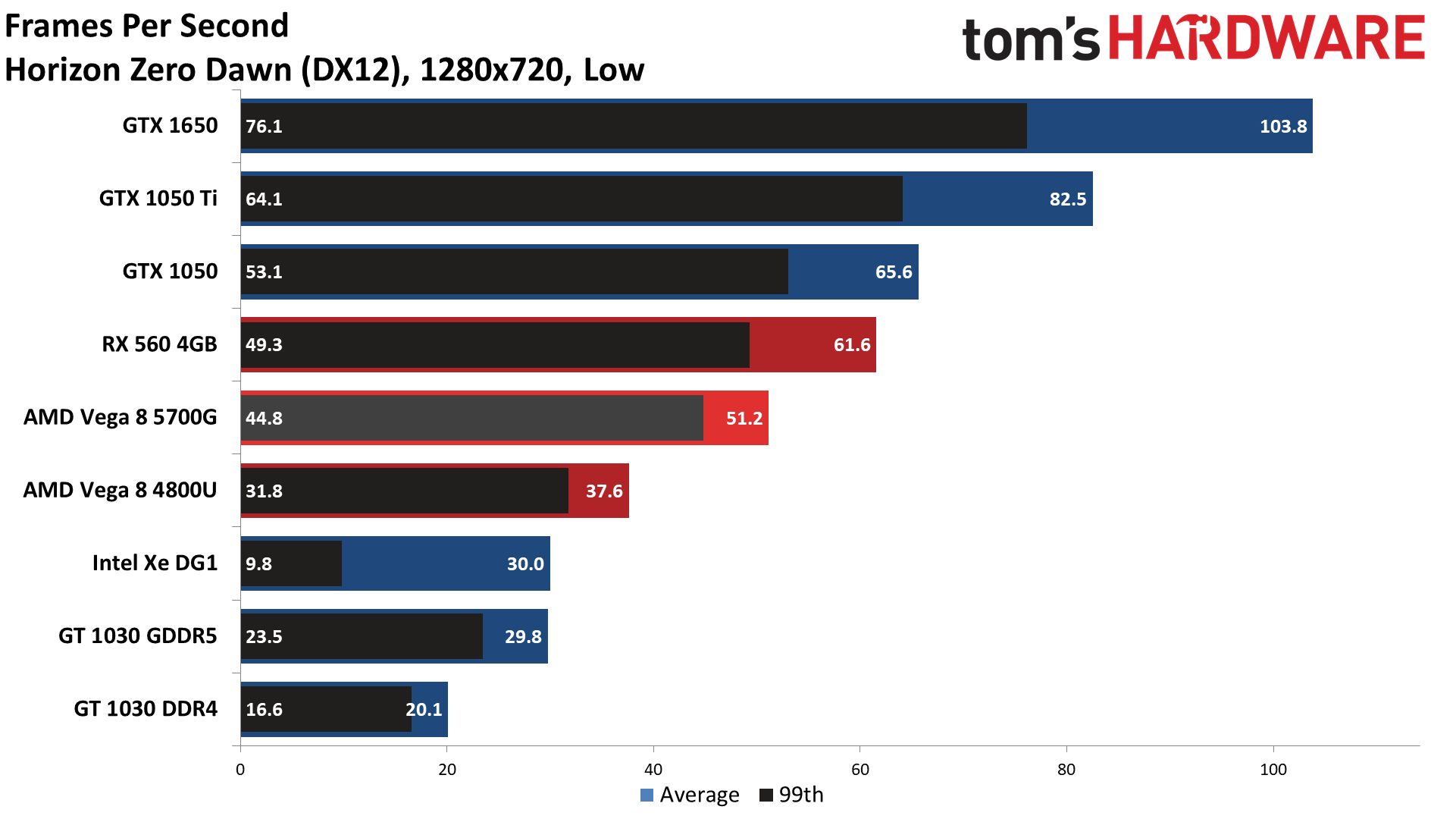
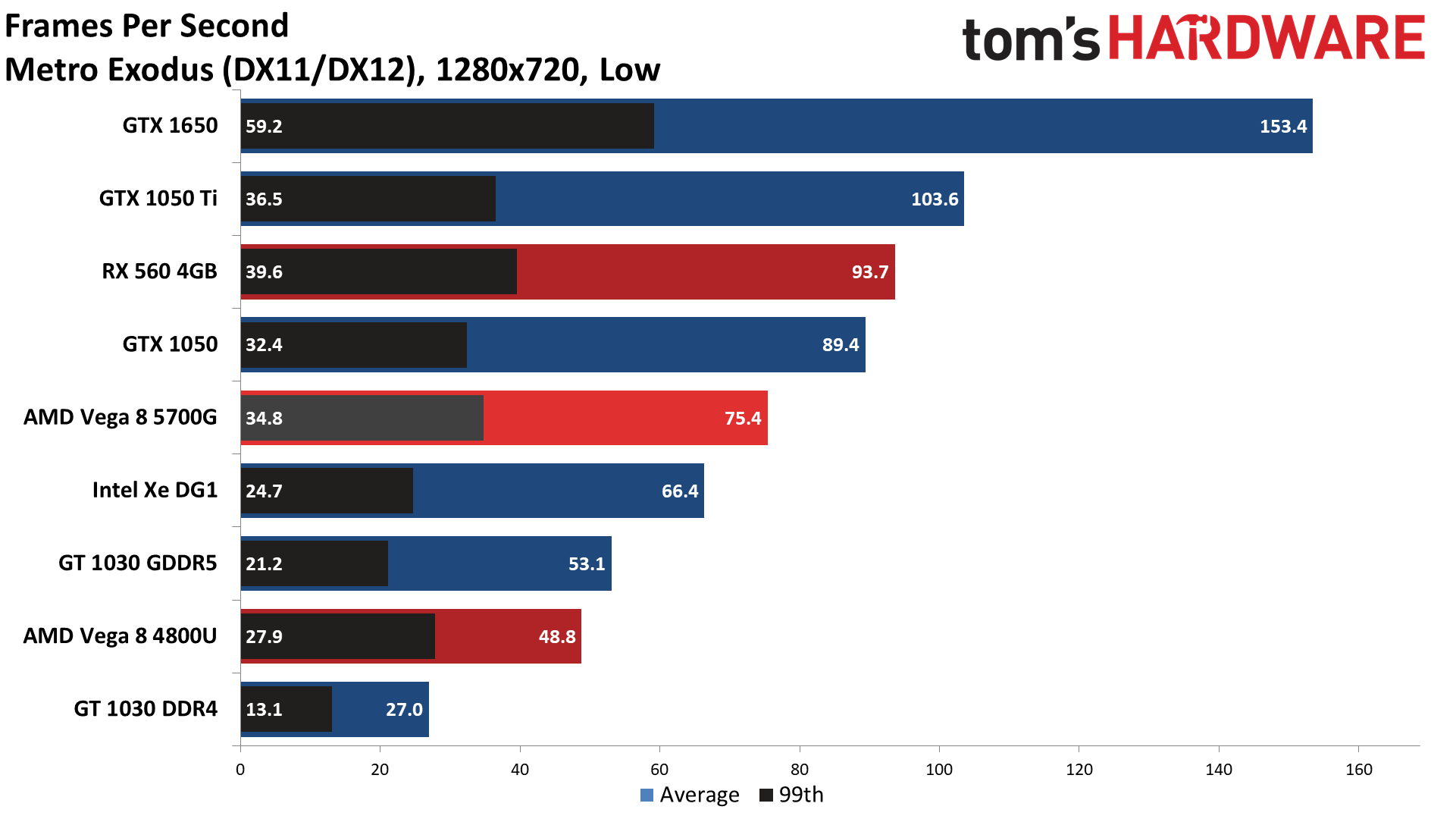

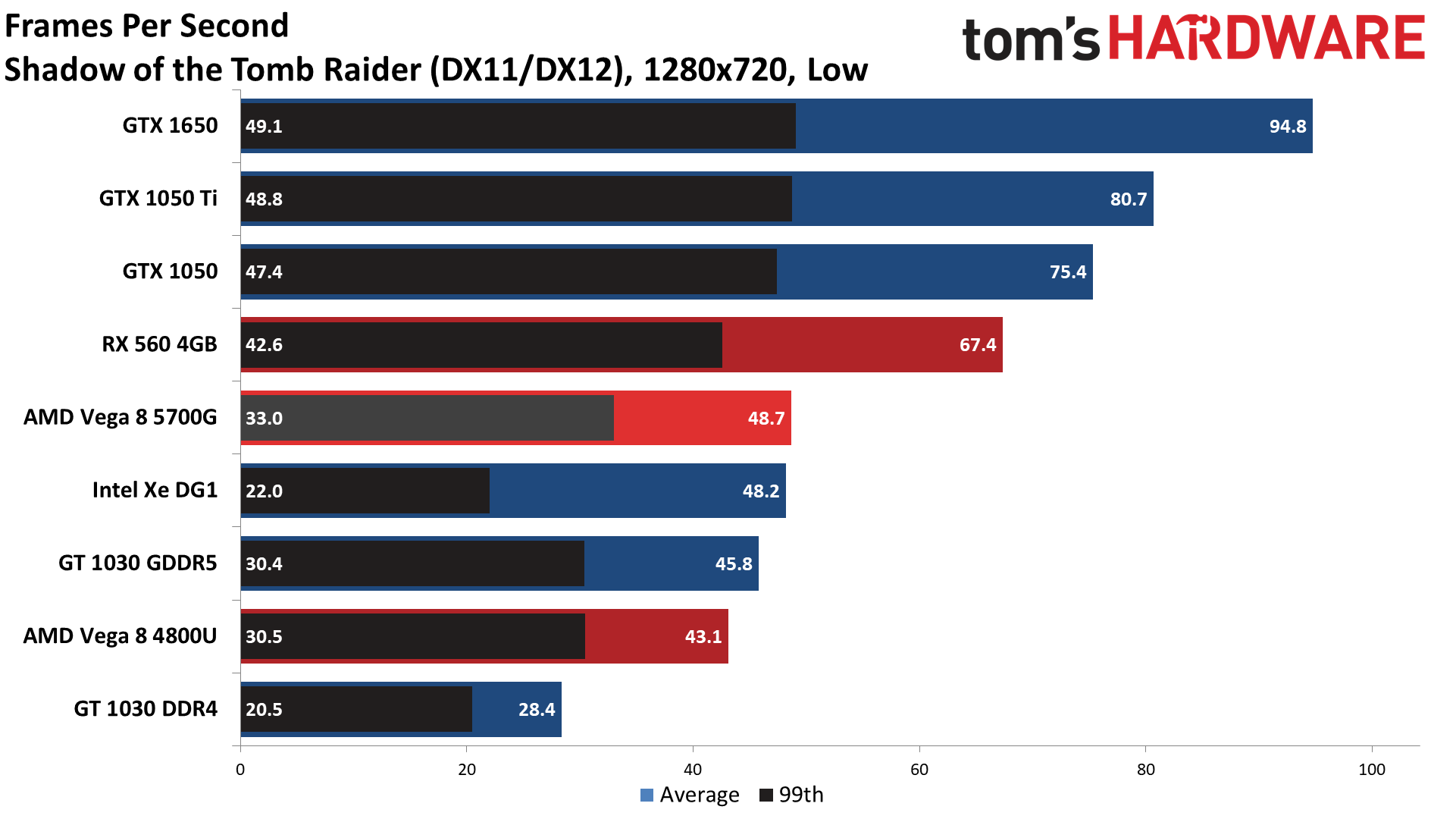
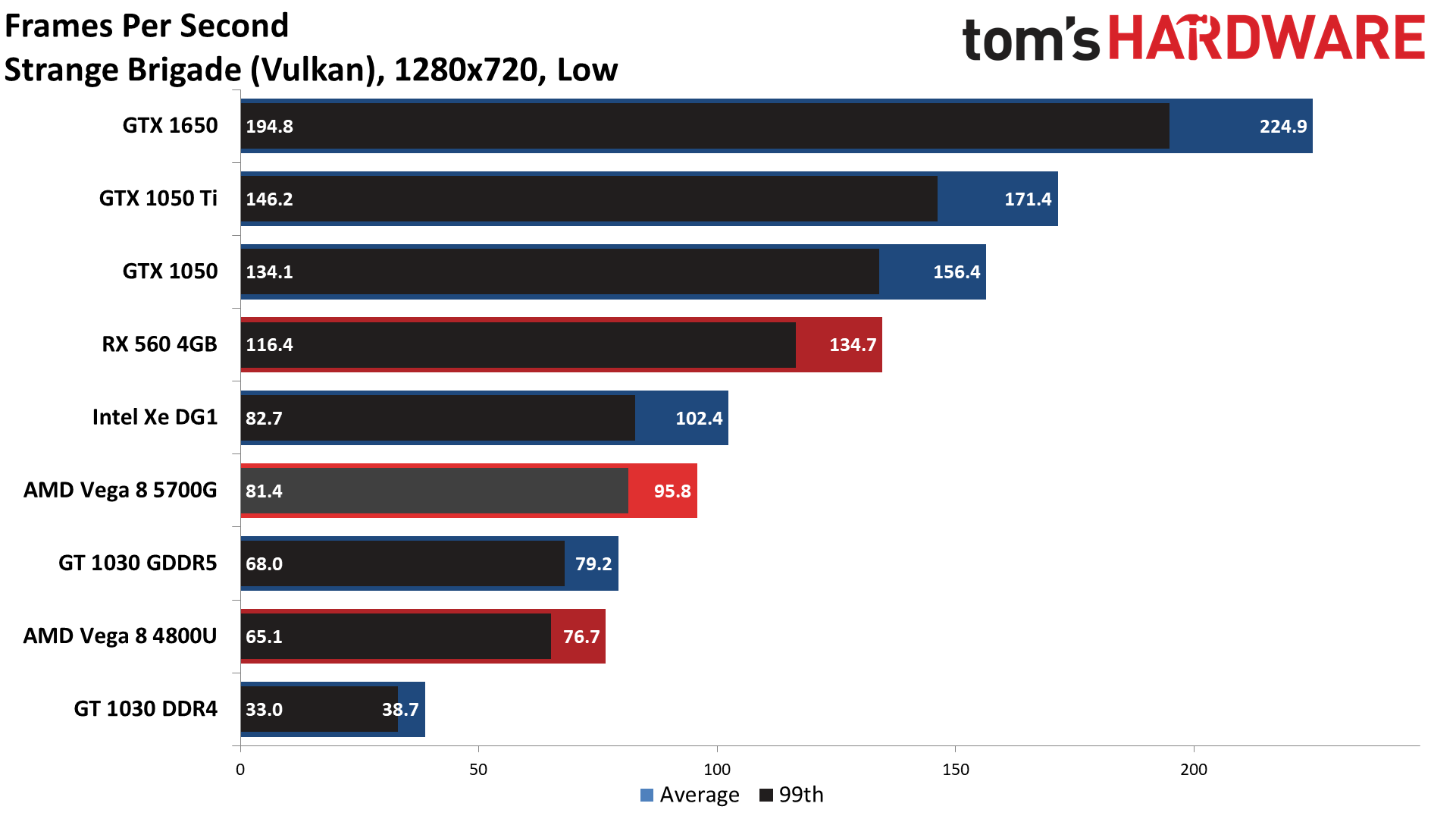
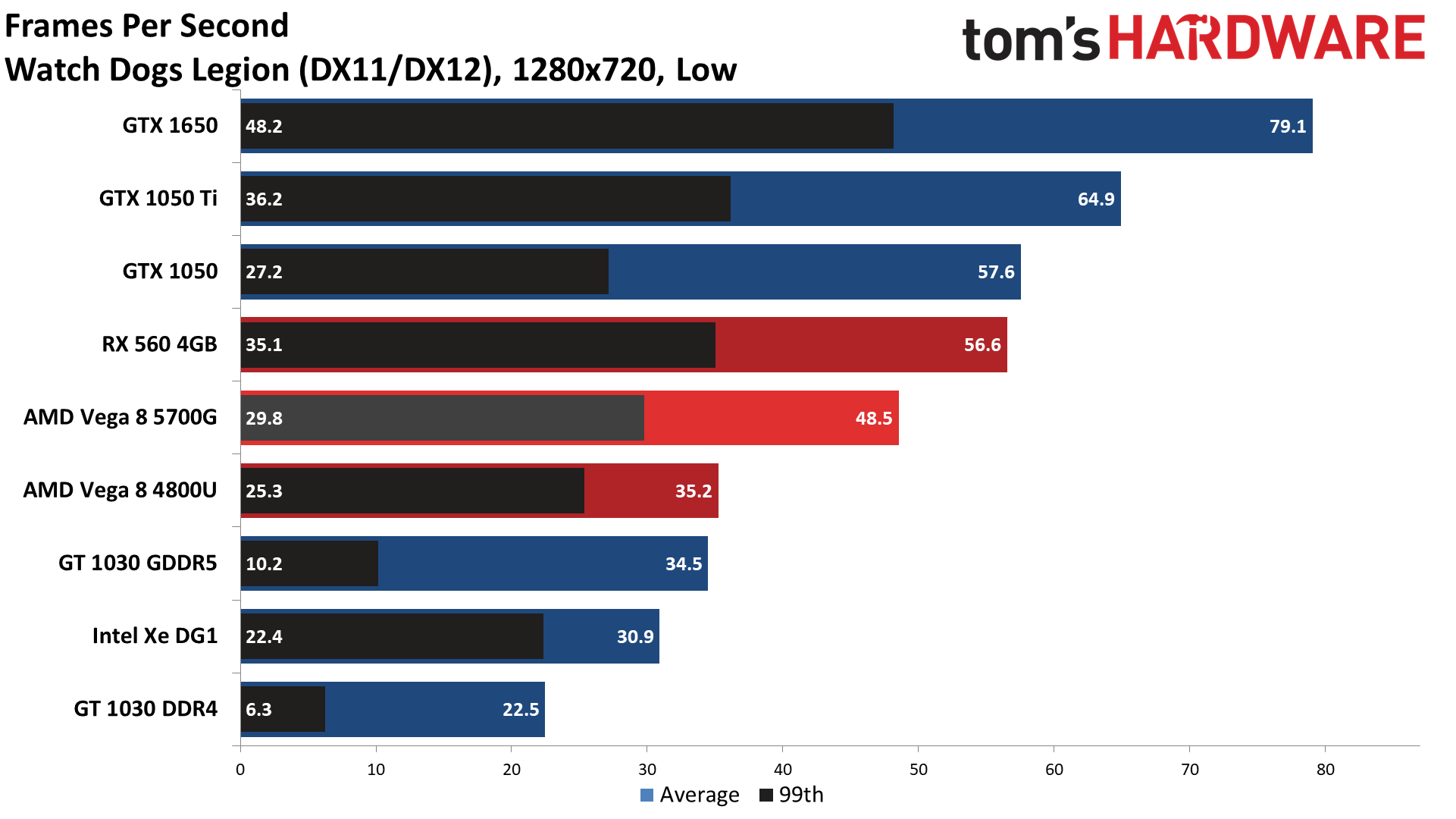
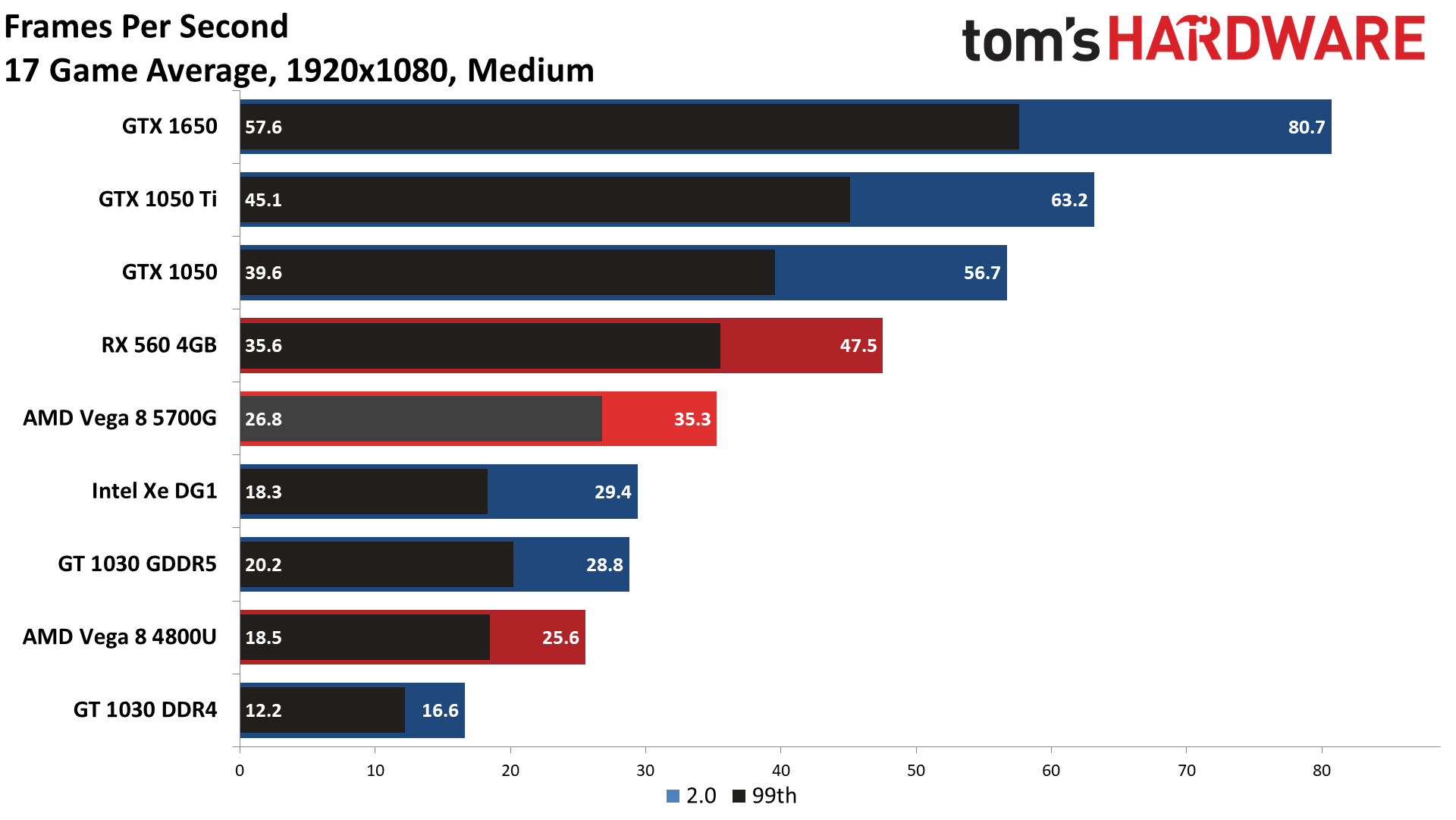
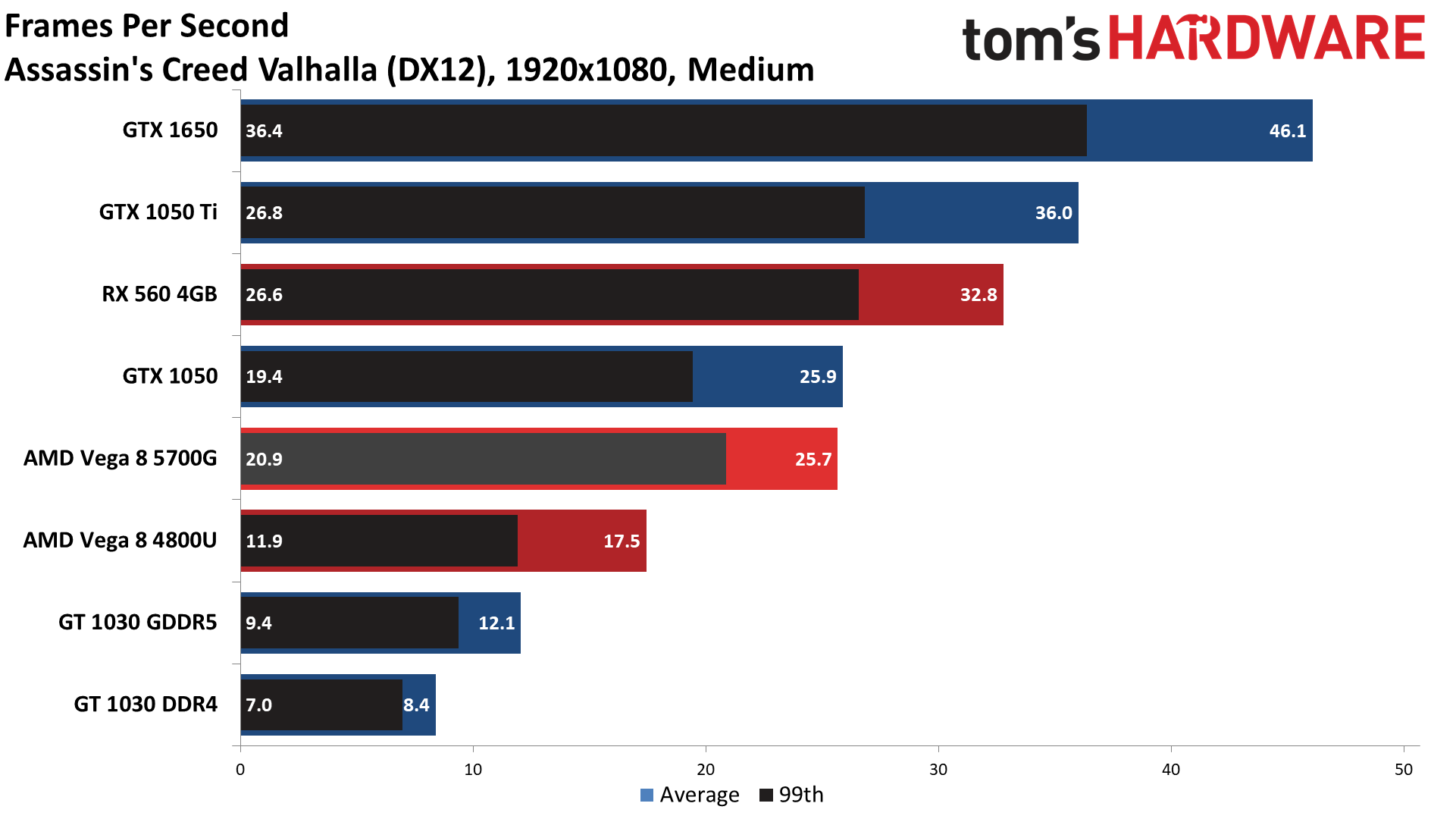
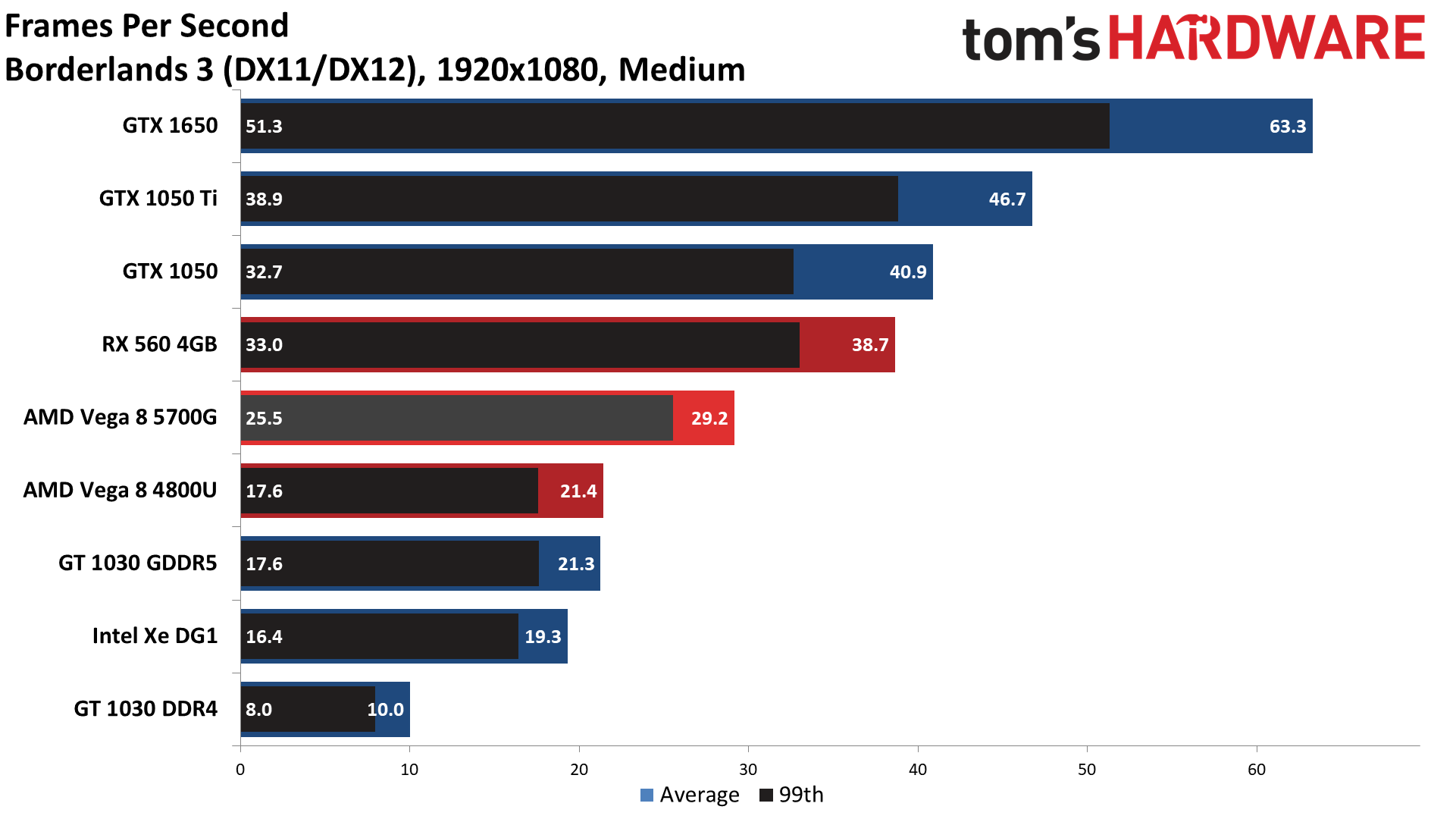
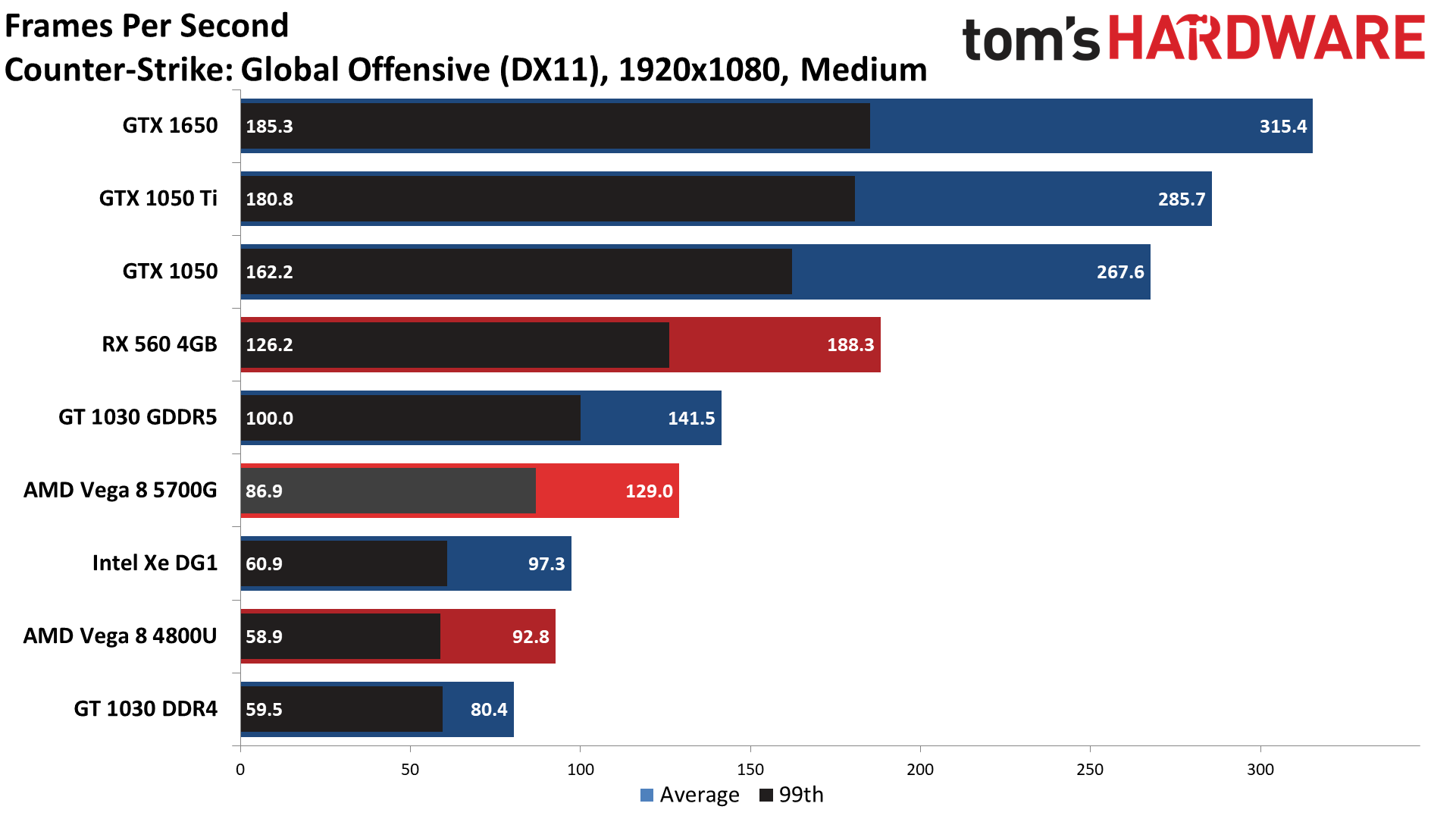
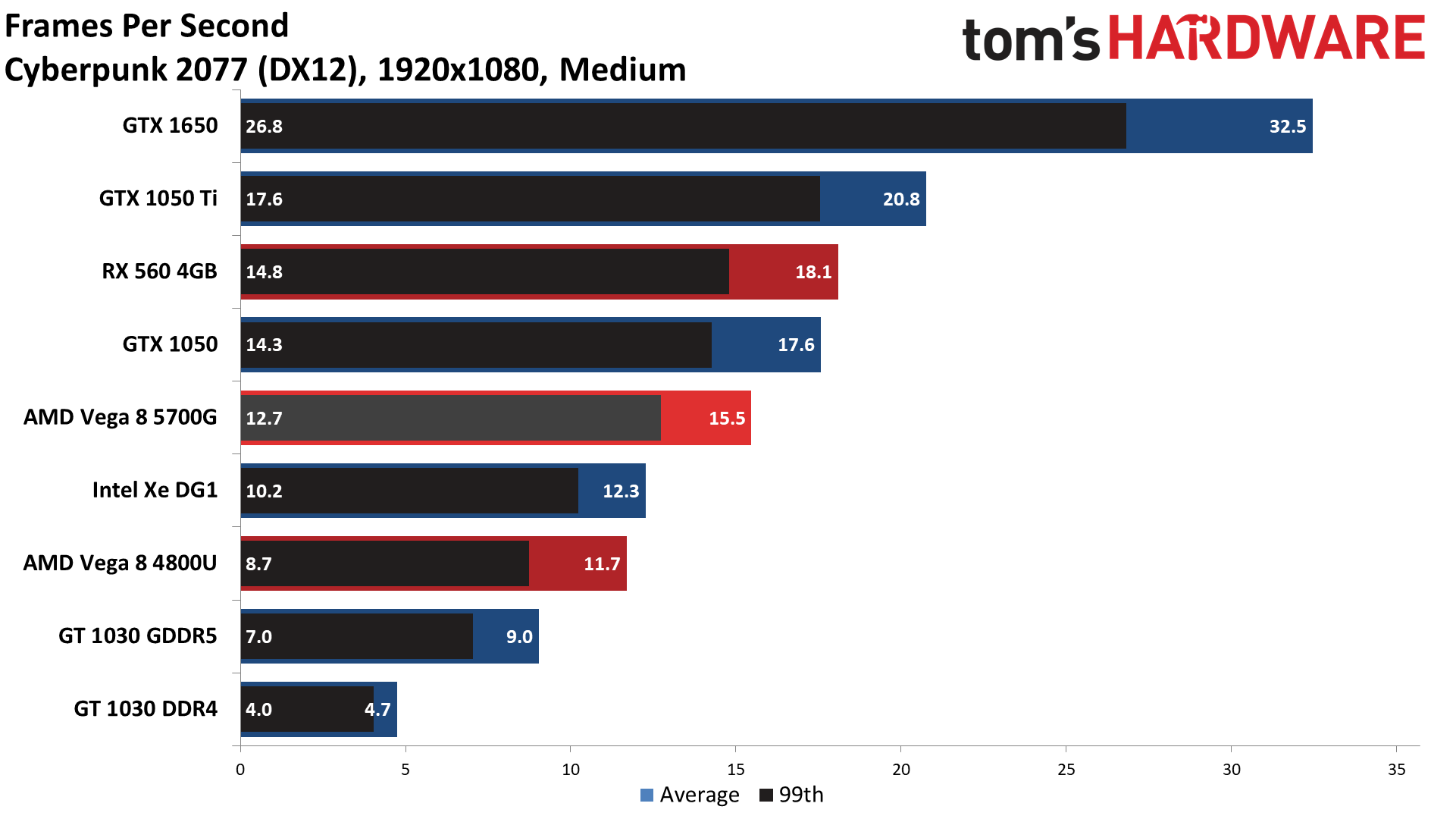
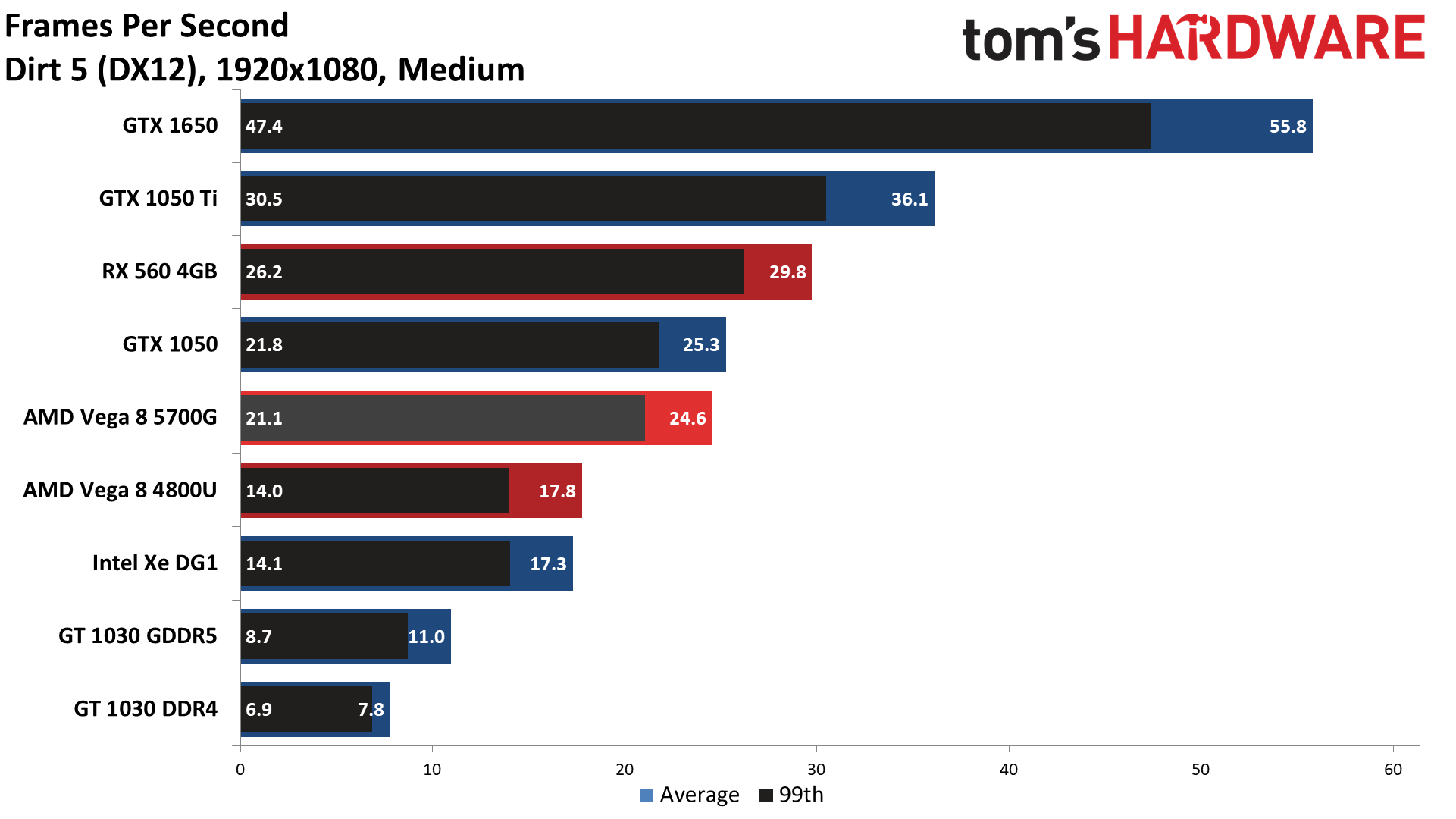
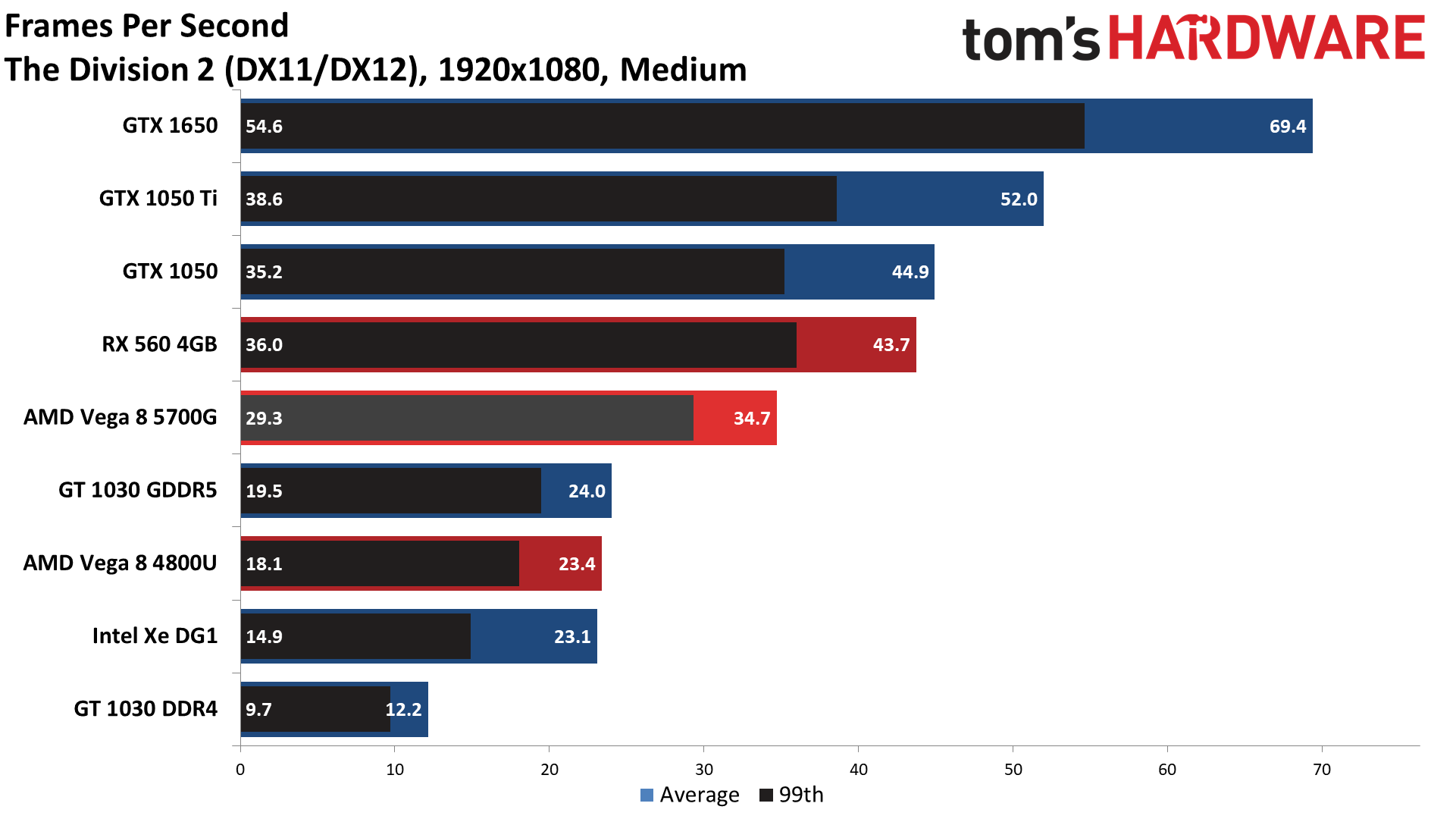
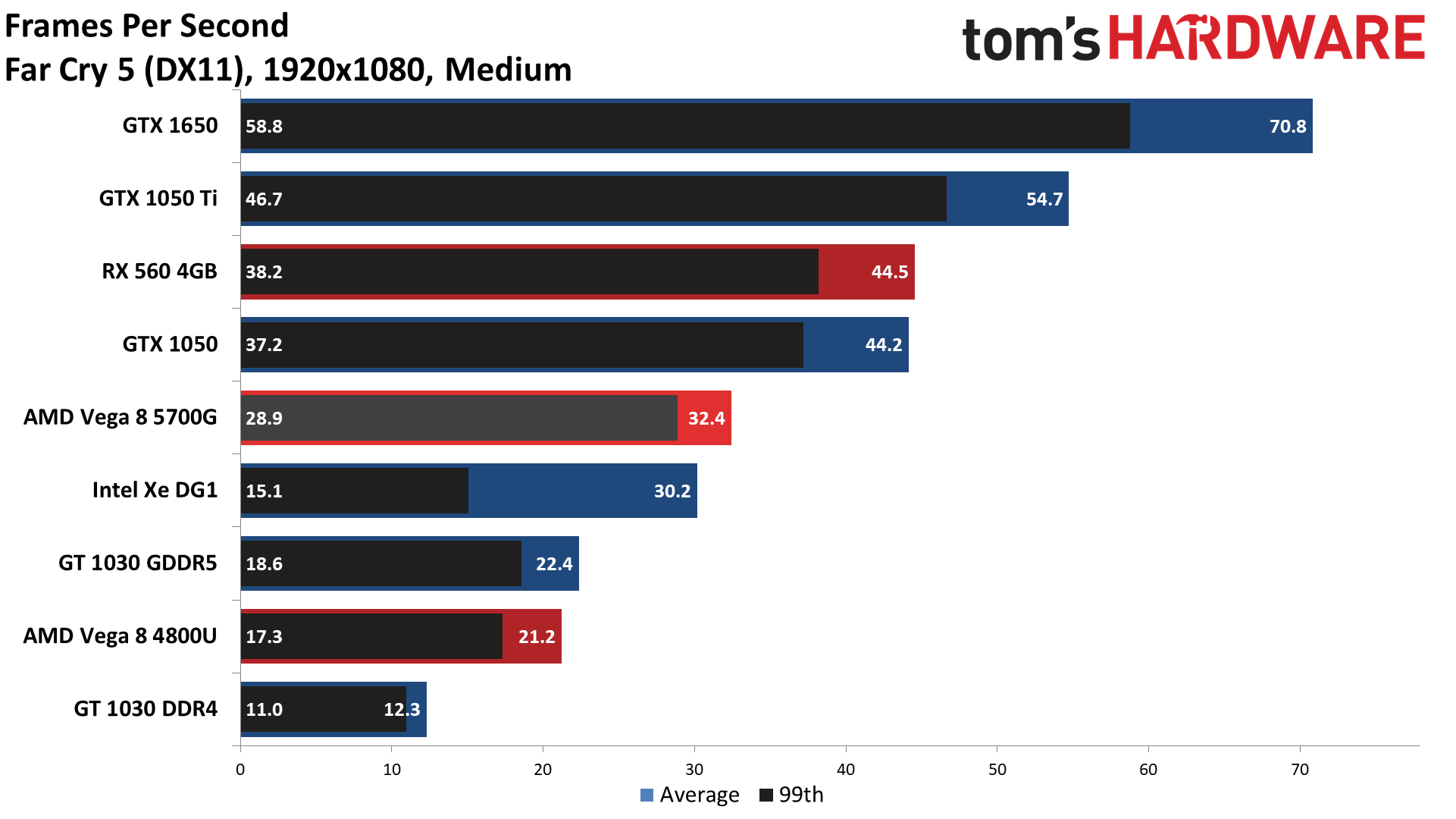
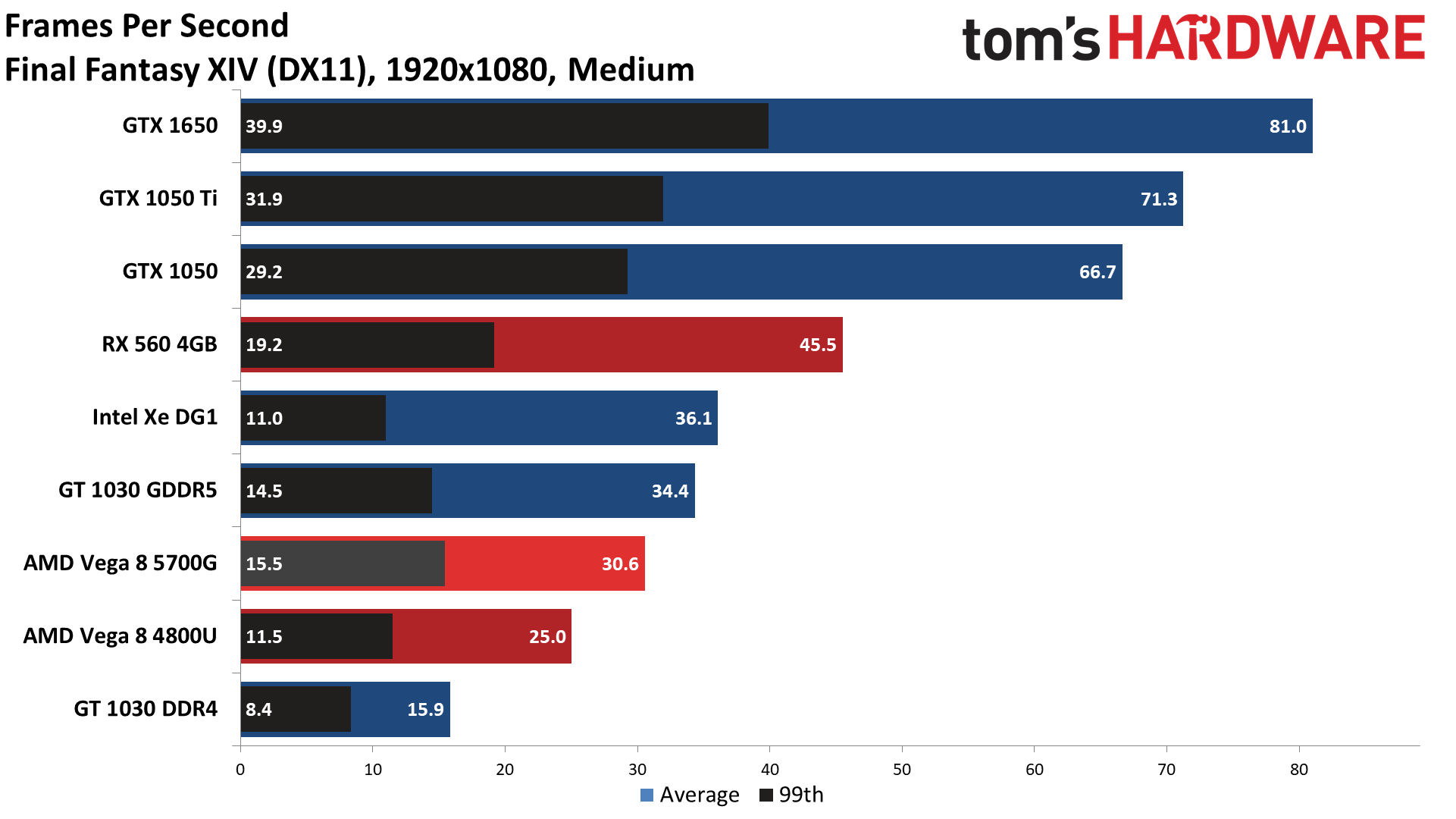
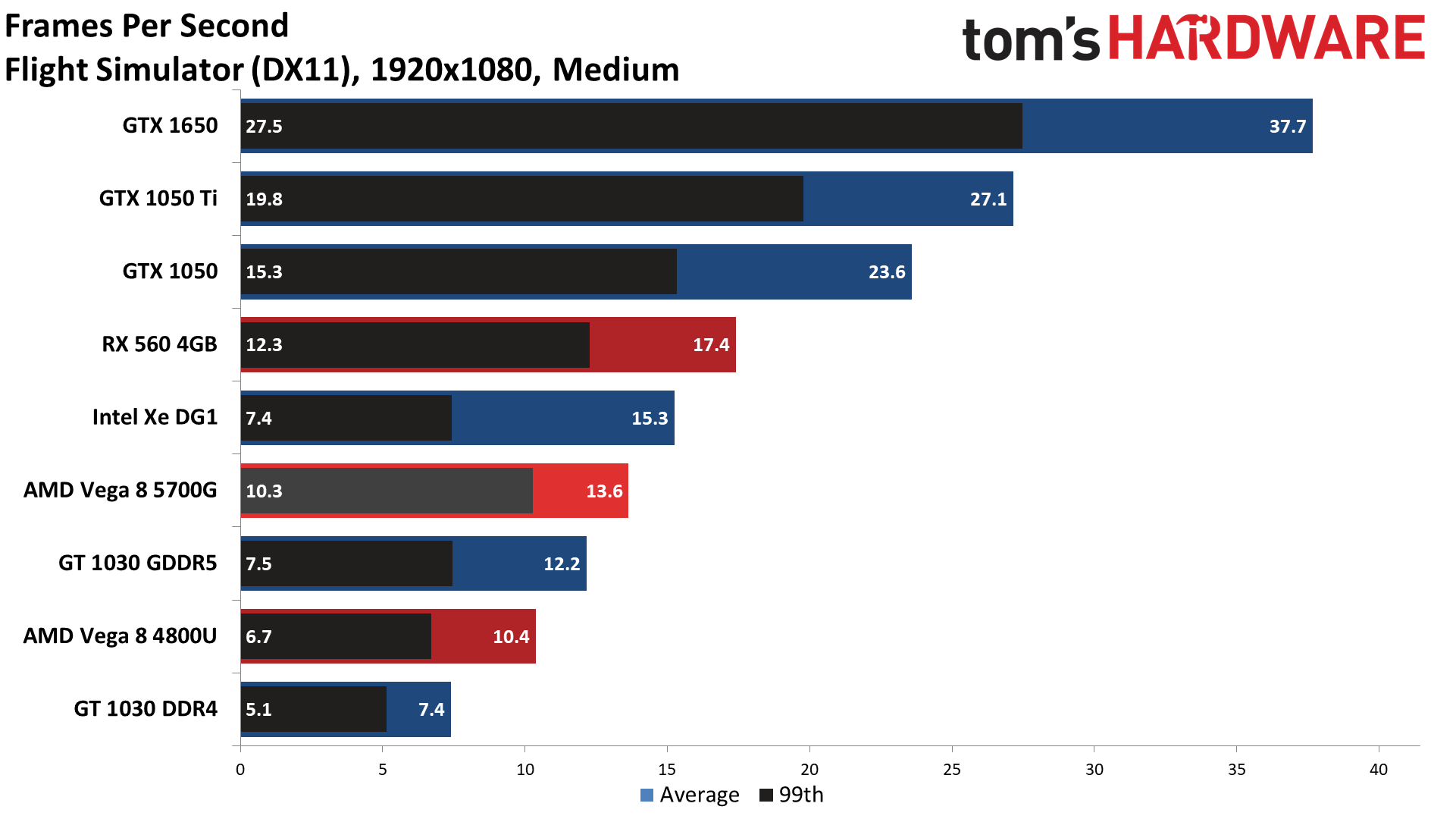
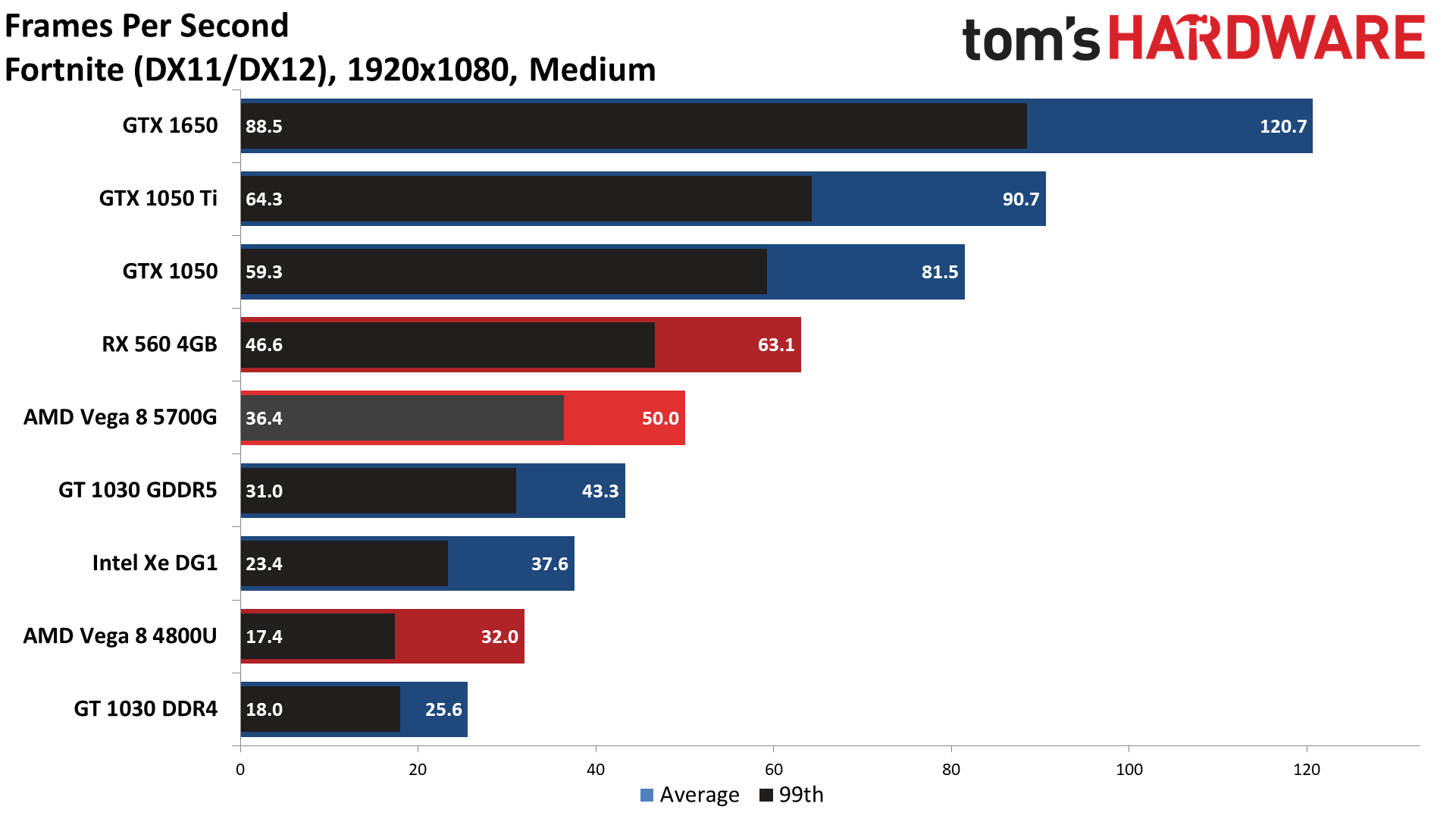
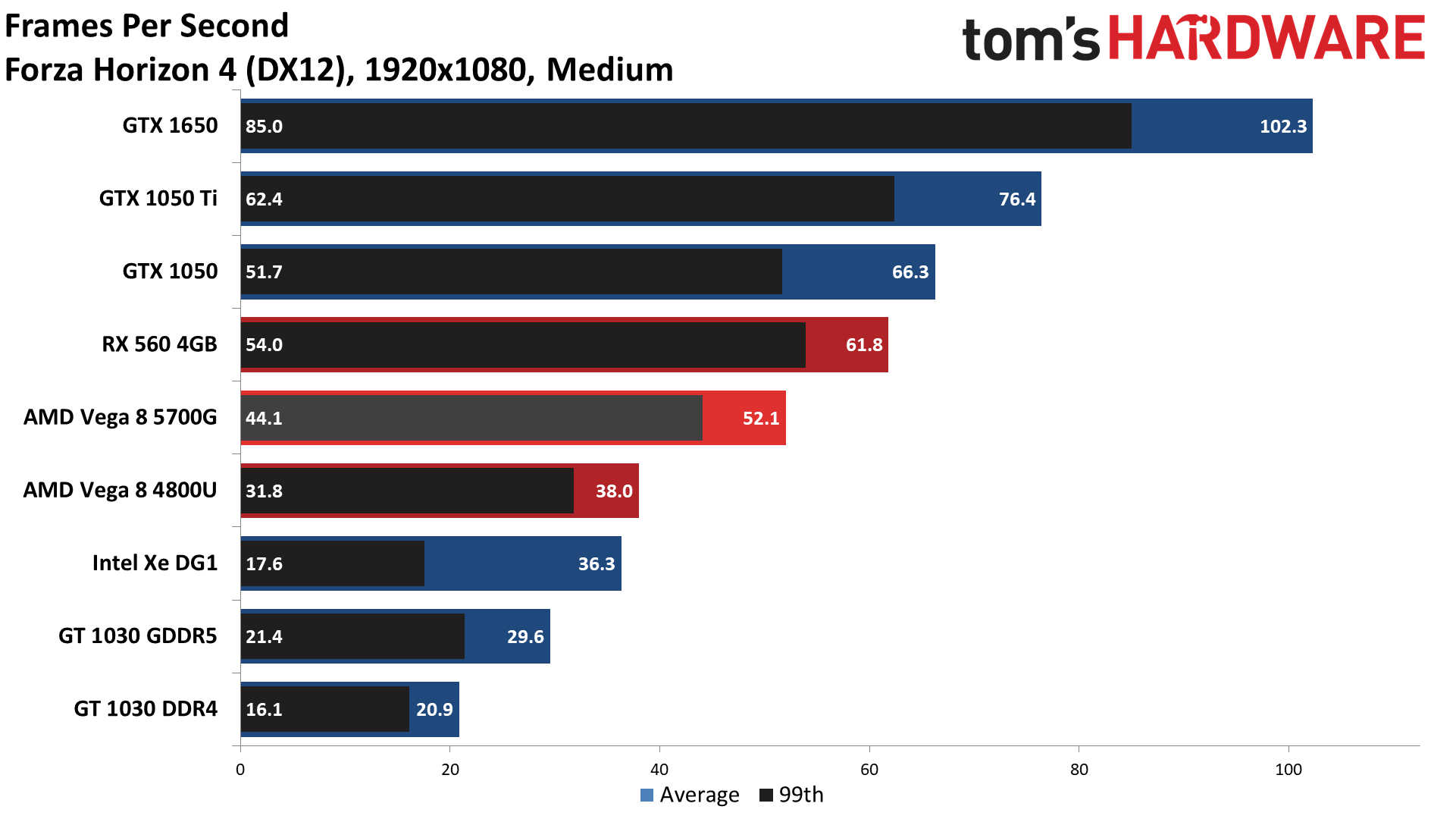
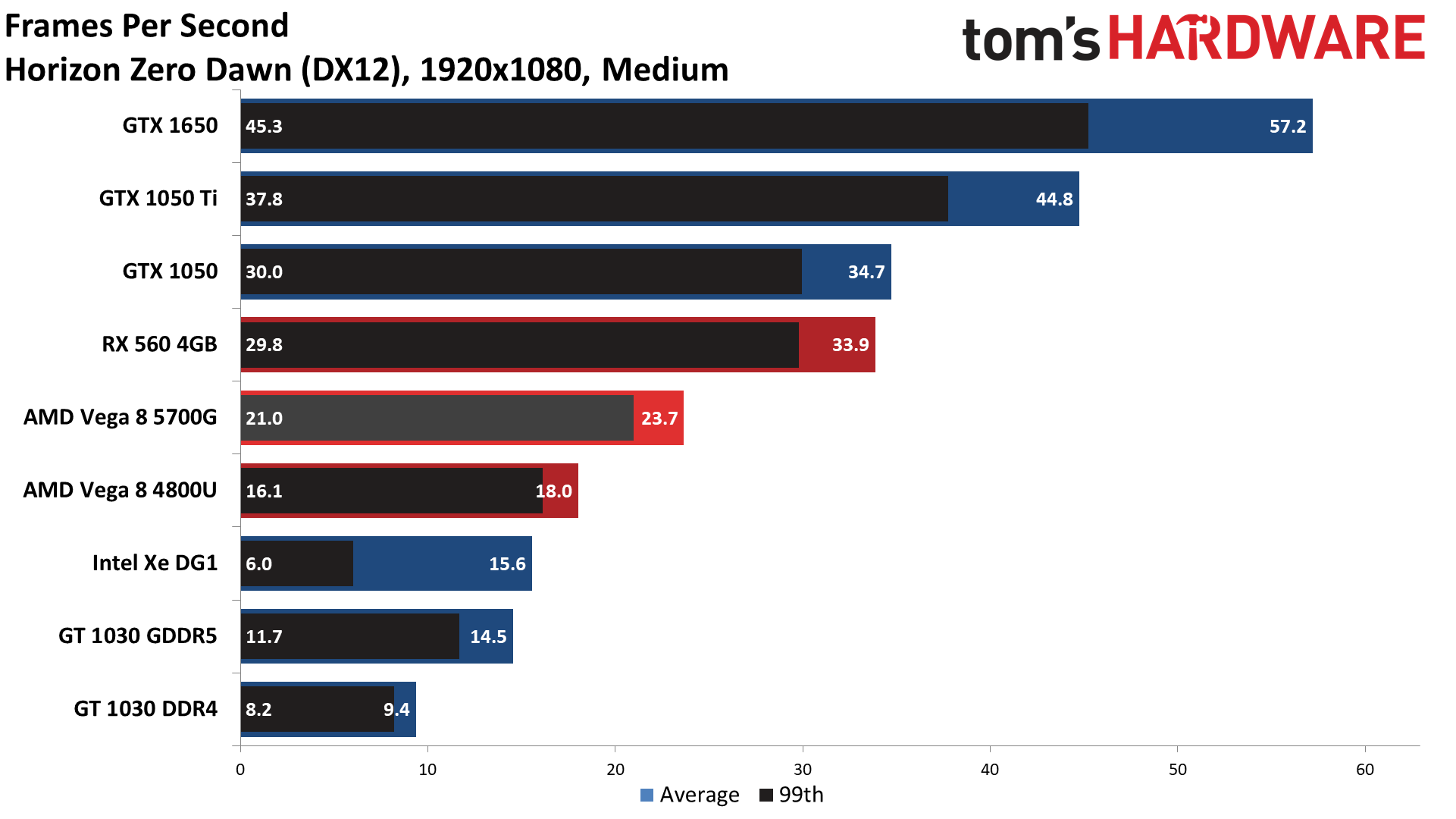
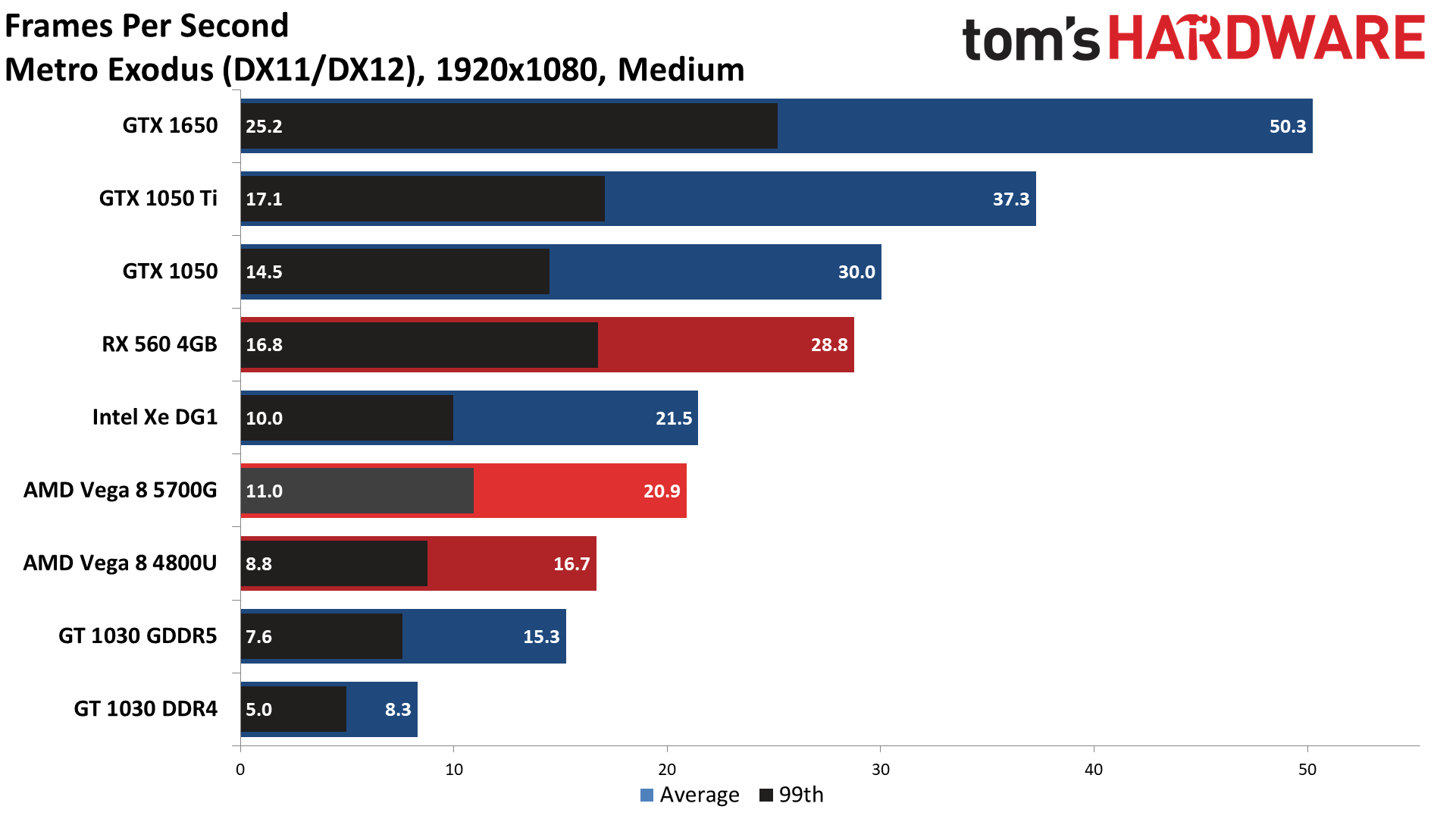
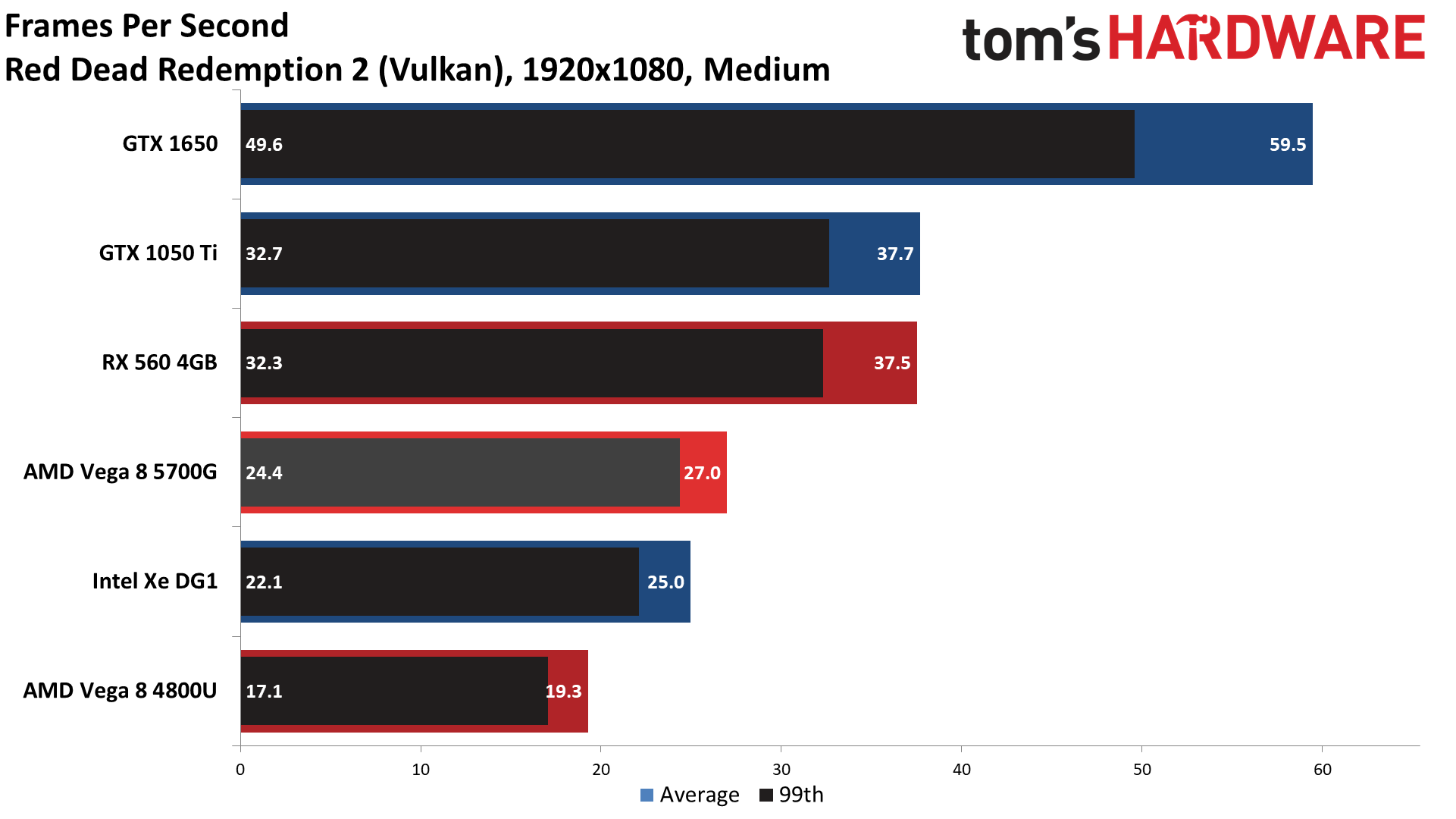

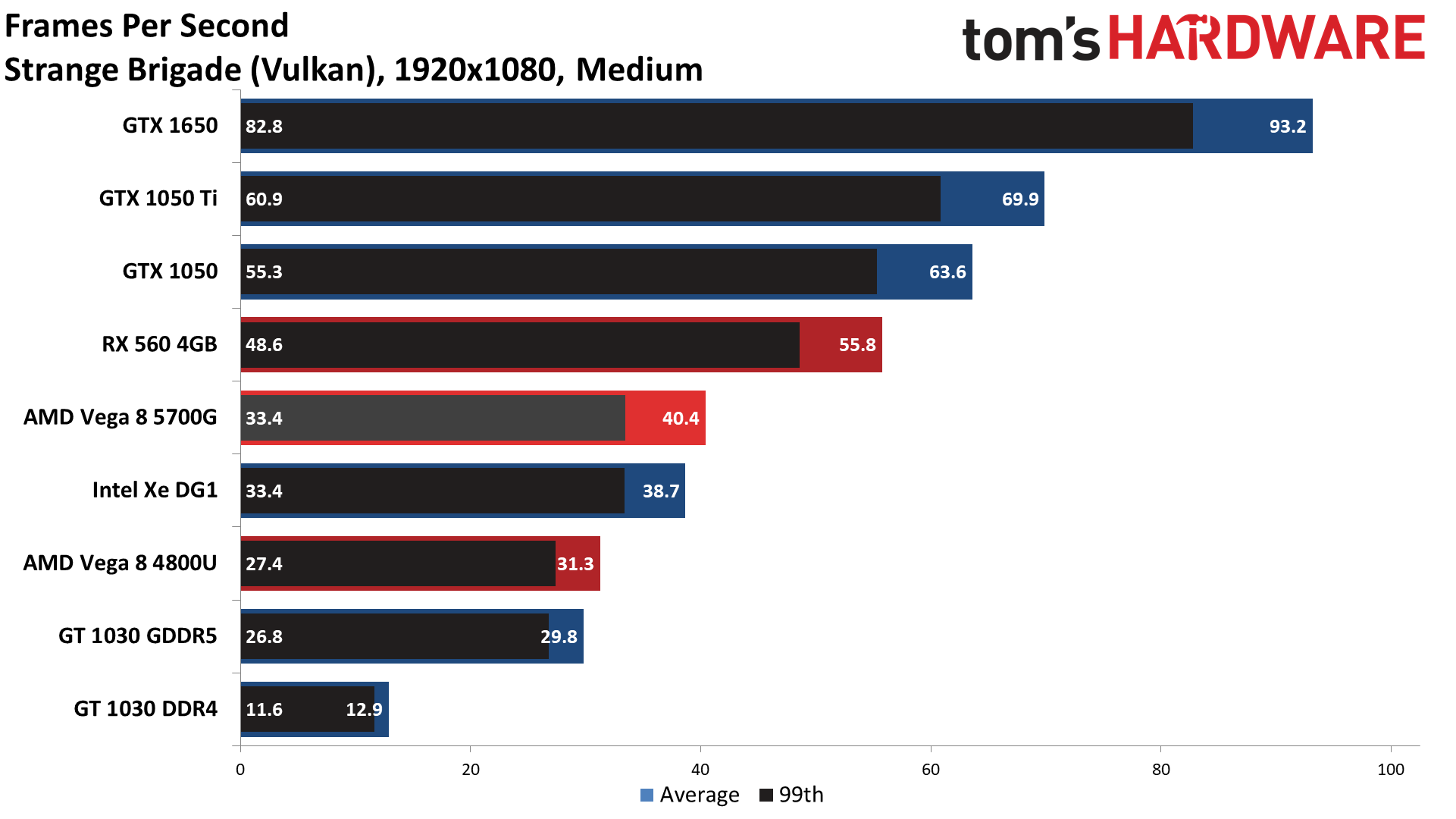
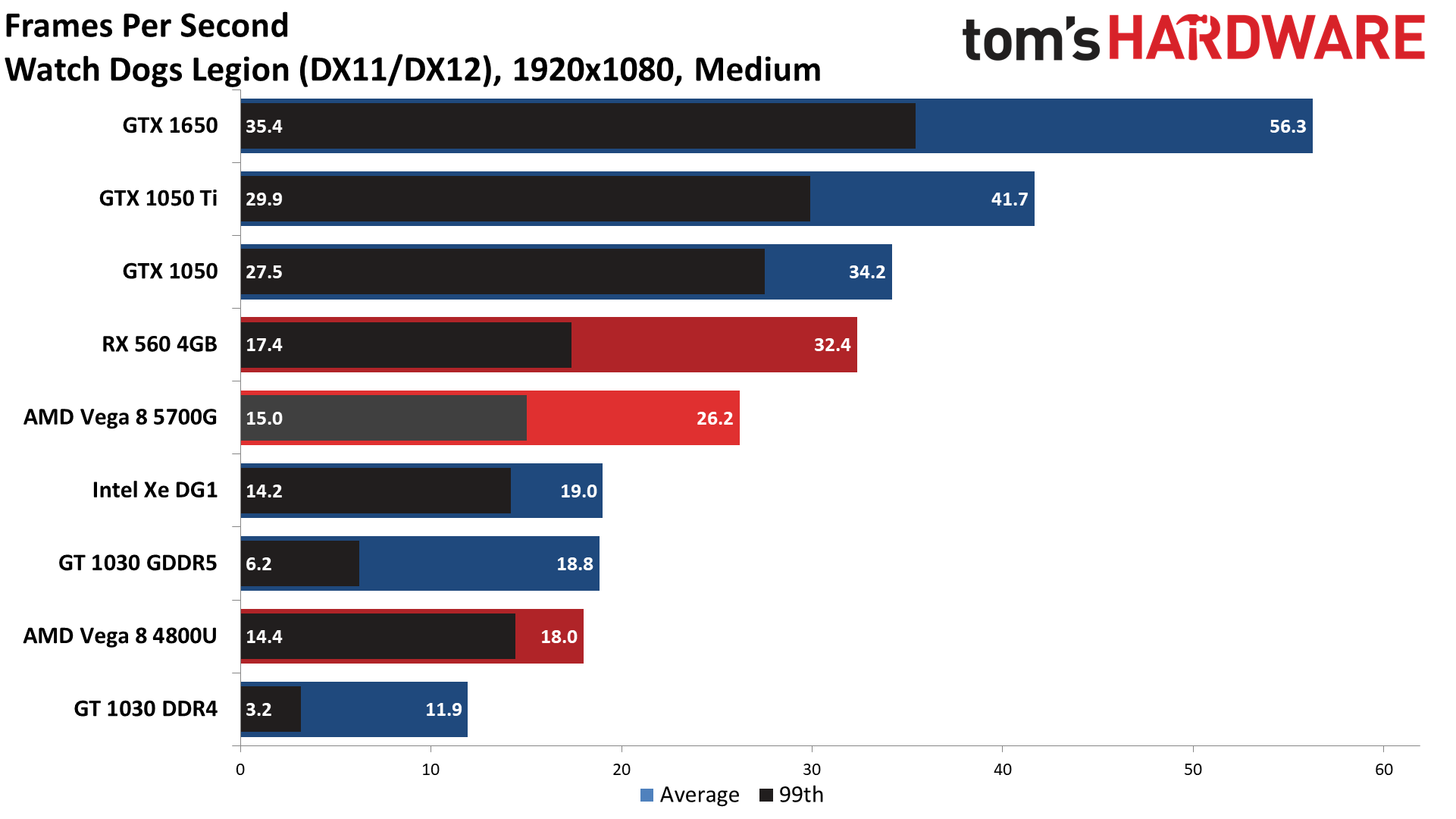
Above you can see how the Ryzen 7 5700G stacks up against the most relevant discrete GPUs. Our GPU editor, Jarred Walton, contributed this extended testing, but he doesn't have a Ryzen 5 5600G for comparison. However, given that we've shown definitively that the 5600G is within 4% to 5% of the 5700G, it's easy to spitball performance with these test results.
Jarred's extended testing shows that the Ryzen 7 5700G is the fastest integrated graphics solution currently available and that it equates to slightly better than GT 1030 levels of performance. At 720p, across a rather demanding test suite, all things considered, the Ryzen 7 5700G was 25% faster than the GT 1030 GDDR5, and 35% faster than Intel's DG1 solution — which delivers similar performance to the Tiger Lake integrated Xe Graphics. The margin of victory shrinks to around 20% at 1080p medium, as the memory bandwidth requirements increase, and this is an area where overclocking and faster memory can help, but frankly, we need DDR5 systems to really deal with the memory bottlenecks. For a deeper look at the low end of the graphics market, head to our recent Intel Xe DG1 Benchmarked: Battle of the Weakling GPUs article.
MORE: Best CPUs
MORE: CPU Benchmarks Hierarchy
MORE: All CPUs Content
Current page: AMD Ryzen 5 5600G iGPU Gaming Benchmarks
Prev Page AMD Ryzen 5 5600G Power Consumption, Overclocking and Thermals Next Page AMD Ryzen 5 5600G Discrete GPU Gaming Performance
Paul Alcorn is the Editor-in-Chief for Tom's Hardware US. He also writes news and reviews on CPUs, storage, and enterprise hardware.
-
hotaru251 i would personally add to the cons: VegaReply
the only problem with this chip is the vega graphics. if they had RDNA it would basically destroy Intel's lower cpu's in cost to performance.
pcie 3.0 isnt really a con at this type of chip. Its a budget chip. -
ndperson Actually it isn't Vega that is limiting their performance but their ddr4 ram. That is why they don't update beyond vega. Vega itself is limited by the speed of the ram so upgrading to rdna really wouldn't help muchReply -
twotwotwo Probably not a priority for Intel, but a TGL desktop chip (that non-OEMs can get) might make this segment more interesting, going by laptop benchmarks.Reply
That or desktop Van Gogh 🤣 but I imagine Valve has all those booked for a while. -
brodon Building an RGB matx non gaming system on a budget, and, not understanding, at 79, much of the language from the tech savvy contributors, I rely a lot on certain comments and reviews to make purchase decisions.Reply
This G series integrated graphic CPU, on a B450M DS3H v.2 mobo and Cooler Master G100M low profile cooler in a NXZT h501i case looks like a workable base configuration.
The rest of the components should be elementary. -
hrudy Most of you won't care about this issue . I was evaluating the AMD Ryzen5 5600G using an existing Linux Image based on Centos 7. I wanted to get away from Intel and try AMD. However, this processor consistently generated Panic Traps, both from the image and even from the Centos 7.9 install disk. I was using a GIGABYTE B550M DS3H . I have never seen an X86_64 part generate Linux Panic traps by just booting. Usually there are minor issues like not seeing the audio or ethernet components. And yes ithe Ryzen 5 5600G will boot from later kernels.Reply
And yes an AMD cpu without the GPU enabled works fine. I then ran into the second problem which is that even with a late Ubuntu distribution the AMD DRM gpu code didn't not want to install. I have never encountered this level of incompatibility since I've been using Linux which is around Y2k. Naturally AMD support doesn't care since it is Linux. For this level of incompatibility I might as well be running an ARM processor. -
tracker1 Replyhrudy said:... AMD support doesn't care since it is Linux. For this level of incompatibility I might as well be running an ARM processor.
It's definitely a mixed bag. I learned this using an RX 5700XT at release. I had to run beta/alpha kernels for the first 6 months or so.. Ubuntu 20.04 was really the first release with decent in the box support and even then better with later kernels. So it's not too surprising.
I also had similar issues with Intel AX wireless at that time (Around x570 Master, motherboard). And that doesn't even cover trying to get RGB in Linux working.
I've since gone back to solid, no window, case. I'm also now on an RTX 3080, as I'm running some video AI stuff that didn't do well with AMD at the time.
Nvidia drivers haven't been the best either. At least at this point it's mostly mature. Unfortunately, bleeding edge hardware and Linux means a bit of pain.
If suggest only running a very recent kernel in hardware released at least 4 months before your OS release. CentOS stable is not that. Should run a recent Fedora instead. I'm not that up on rpm distros, preferring Debian based myself. I know there are a couple newer white box RedHat options though. -
render1967 Hi, guys! I have a question. Help me, please! Does the built-in video in 5600G support analog signal via D-sub? I ask because I have a problem with this - there's no signal via D-sub. Computer configuration: CPU Ryzen 5 5600G, MB ASRock B450M Pro4-F R2.0, RAM ADATA XPG GAMMIX D10 16GB (2x8GB) DDR4 3000MHz, HDD ADATA Ultimate SSD SU650 120GB + Apacer AS2280P4 M.2 PCIe 512GB, PSU FORTRON HYPER K PRO 500W, monitor ASUS VH222SReply -
Girl_Downunder Replyhrudy said:Most of you won't care about this issue . I was evaluating the AMD Ryzen5 5600G using an existing Linux Image based on Centos 7. I wanted to get away from Intel and try AMD. However, this processor consistently generated Panic Traps, both from the image and even from the Centos 7.9 install disk. I was using a GIGABYTE B550M DS3H . I have never seen an X86_64 part generate Linux Panic traps by just booting. Usually there are minor issues like not seeing the audio or ethernet components. And yes ithe Ryzen 5 5600G will boot from later kernels.
And yes an AMD cpu without the GPU enabled works fine. I then ran into the second problem which is that even with a late Ubuntu distribution the AMD DRM gpu code didn't not want to install. I have never encountered this level of incompatibility since I've been using Linux which is around Y2k. Naturally AMD support doesn't care since it is Linux. For this level of incompatibility I might as well be running an ARM processor.
I wondered if you asked at the Ubuntu forums on this issue. I personally run Mint Mate on an old 4th gen i5 desktop. I'm looking to upgrade to "nearly" the newest (not worried about PCIe 4) and have been eyeing the 5600G due to price as well as preferring iGPU as a backup if dedicated fails. Reading this has me a bit worried. Runs off to the Mint forums to see what I find there!
